Introduction
In this article I will highlight my MLB Top 100 Prospects, including a handful of honourable mentions. Each player will have a graphic associated with them that includes information such as biographical data, MiLB statistics, and, most importantly, my scouting grades. These grades are on the traditional 20-80 Grade Scouting Scale and were determined through both statistical and video analysis.
As I learned through this process, the task of writing and compiling a Top Prospects list is not easy. The plethora of research required is time-consuming, and that does not consider the complexity of scouting. I have consumed countless amounts of baseball content in my life, and I would like to thank everyone that inspired and provided me the knowledge to undertake this project.
Let’s cover some important parts of my scouting process:
I defined a MLB Prospect as: Any player signed to a MLB Team that has no more than 130 AB or 50.0 IP
I used the 20-80 Scale for my scouting grades with Present Value (PV) and Future Value (FV) in the format of PV/FV
Some other notes:
The backend of any Top 100 Prospect list is extremely fluid, and mine is no exception. You could argue that close to 150 Prospects deserve the title of a Top 100 Prospect, and I would agree
The backend of my list is more to highlight players that I particularly like, and the Honourable Mentions include a variety of players that deserve recognition
As always, I encourage constructive criticism! I would be happy to discuss any prospect on this list or any others that you have questions about
I am human. Please inform me if I made a mistake!
Now, with that out of the way, we can get to the list. Enjoy!
1) Kevin McGonigle - SS - DET
The Good
Kevin McGonigle is the best hitter in MiLB, and it's not particularly close. He pairs elite bat control with an exceptional eye and above average power to be a menace at the plate. Tack on average speed and defense, and you have the blueprint for the #1 prospect in baseball!
The Bad
The power may not translate to a ton of home runs and more so doubles. He might not stick at SS, but projects to be solid at 2B.
2) Chase Burns - RHP - CIN
The Good
Chase Burns added a strong changeup to his already elite fastball/slider combo to give him one of the most wicked arsenals in MLB. His strike throwing improvements cannot be understated. He is a budding ace!
The Bad
More trust in his changeup would be ideal as well as an additional breaking ball to complement his slider. Also a recent flexor strain is bad news.
3) Konnor Griffin - SS - PIT
The Good
The most tooled up prospect in MiLB, Griffin boasts potential plus-plus power and 70 grade speed. The hit tool concerns seem to be in the rearview for the heir to the prospect throne. He also looks comfortable all over the field.
The Bad
Breaking balls tend to give him the most trouble, both in terms of chases and whiffs.
4) Jacob Misiorowski - RHP - MIL
The Good
Jacob Misiorowski has taken MLB by storm with his 80-grade fastball and blazing secondaries while making massive strides in the command department. He sits with Burns as the two best pitching prospects in baseball.
The Bad
The BB% remains below average and he struggles to land first pitch strikes consistently.
5) Jesús Made - SS - MIL
The Good
Jesus Made is showcasing MLB average power at just 18 years old and continues to impress with above average contact rates and a patient approach. His ability to punish any type of pitch at such a young age in jaw-dropping.
The Bad
An exorbitant number of pop-ups have limited his power output, and he is not hitting nearly enough fly balls.
6) JJ Wetherholt - SS - STL
The Good
Wetherholt has a keen eye while being moderately aggressive at pitches in the zone. He supplements his sturdy approach with an above average hit tool and a consistent ability to barrel the ball.
The Bad
His defense remains a question. He will likely move off of SS for either 2B or 3B, which are better suited for his capabilities.
7) Max Clark - OF - DET
The Good
Max Clark carries an entire toolshed on his back every time he steps foot on the field. Massive gains in his approach and contact rates buoyed his stock while plus speed and defense makes him a very dynamic outfielder. No one tool carries his profile; it is a well-rounded toolkit that gives him a tantalizing floor.
The Bad
He fails to lift the ball consistently to tap into his power. He also falls victim to being too passive.
8) Samuel Basallo - C - BAL
The Good
Basallo is the best power hitter in MiLB and has been for quite some time. He has posted excellent EVs and Barrel% at every level and is knocking on Baltimore's door to continue his success in MLB.
The Bad
His hit tool is good enough to let the power play, however his poor swing decisions could lead to speed bumps along the way. His upside is also limited due to his poor speed and likely departure off catcher.
9) Bubba Chandler - RHP - PIT
The Good
A plus-plus fastball and strong slider paved the way for Chandler to be an exciting pitching prospect, and his changeup development has vaulted him up the ranks.
The Bad
His command hasn't taken the same leap as his changeup did last season, and he is prone to inefficient outings. Nonetheless, he should have been called up by now.
10) Luis Peña - SS - MIL
The Good
Potential plus-plus hit tool and blistering speed carries Pena's projection, but his raw power should not be understated. He has a greater 90th% EV than fellow teammate Jesus Made!
The Bad
Pena's power ceiling is more restricted due to his smaller frame and flatter swing plane. His contact rates against breaking balls are worrisome.
11) Carson Benge - OF - NYM
The Good
Benge has solidified himself as one of the most complete prospects in MiLB. None of these tools are exceptional, yet they all grade out at least average to make him one of the safest bets to be an MLB regular, especially as a CF.
The Bad
His spray tendencies and flatter bat path will likely limit his power upside.
12) Josue Briceño - C - DET
The Good
Briceno is one of the most well-rounded hitters in MiLB. He combines a formidable hit tool with a sharp eye and elite bat speed to strike fear into pitchers.
The Bad
He has some trouble hitting off-speed pitches and his contact rates have dipped following his promotion to AA. He is gradually being eased off of backstop, which puts a damper on his overall profile, but the bat carries him to the higher tiers of prospects.
13) Colt Emerson - SS - SEA
The Good
Plus bat speed and one of the best SS defenders in MiLB. Good balance of patience and aggressiveness which pairs well with his above average contact rates.
The Bad
A flatter bat path will limit his slugging potential, and he struggles to consistently turn on fastballs.
14) Leo De Vries - SS - ATH
The Good
Now on the Athletics, De Vries looks to continue producing at an above average rate as an 18-year-old in Hi-A. De Vries has an advanced eye which supplements his aggressive approach well. He is a tooled-up switch-hitter with immense potential and seemingly unprecedented success given his age.
The Bad
The power he flashed last season hasn't developed as much as expected, which caused him to slip outside of the Top 10.
15) Sebastian Walcott - SS - TEX
The Good
Sebastian Walcott forced himself to AA at just 19 years old thanks to his jaw-dropping bat speed and plus sprint speed.
The Bad
Despite the decrease in strikeouts this season, Walcott has hit a speed bump due to his flat swing plane and an uncanny amount of pop ups. He is also overpowered by breaking balls at this point.
16) Andrew Painter - RHP - PHI
The Good
His stuff screams of a front of the rotation arm and his command continues to gradually improve. His fastball flirts with triple digits, and his slider is one of the most refined offerings in MiLB.
The Bad
The last time he hit triple digits was prior to his Tommy John Surgery and he has had some trouble putting away batters this season.
17) Edward Florentino - OF - PIT
The Good
Strong knack for barrelling the ball at just 18-years old. Ranks near the top of his peers is every conceivable power metric while showcasing a patient approach. Strong contact rates against all pitch types and rarely misses in the zone. Plus-plus arm strength will play well in the corners.
The Bad
Struggles against LHP are well documented. Might not have the athleticism required to play in CF and he has started a few games at 1B.
18) Rainiel Rodriguez - C - STL
The Good
Advanced power and potential plus defense from an 18-year-old catcher is almost a dream. He is making smart swing decisions while running average contact rates.
The Bad
In-Zone contact has been an issue for him this season. He has also struggled with breaking balls. The hit tool may end up being below average.
19) Gage Jump - LHP - ATH
The Good
An electric fastball that jumps out his hand from a lower slot which plays extremely well in the zone. A plus slider and average curveball give him versatile breaking balls to tackle both handedness. His changeup is a work in progress, but flashes above average traits.
The Bad
Jump's biggest drawback is his violent delivery, although his strike throwing has greatly improved this season. He has some relief risk, but the arsenal paints the picture of a future mid-rotation arm if he can remain consistent.
20) Thomas White - LHP - MIA
The Good
A lively fastball and killer slurve have allowed White to dominate lower minors hitters with ease. The development of his changeup and introduction of a new slider have led to laughable results in AA and has him in the race for the top LHP Prospect in baseball.
The Bad
There are still concerns surrounding his command. Below average Strike% and Zone% aren't ideal and have led to a poor BB% throughout his pro career.
21) Bryce Eldridge - 1B - SF
The Good
Monster power from the left side with a solid eye. He may have more untapped power in his 6'7" frame and should be an imposing force both at the plate and first base.
The Bad
With his size and strength, whiffs will be a plenty. To add onto the pessimism, his contact rates against secondaries are terrifying.
22) Bryce Rainer - SS - DET
The Good
Rainer was on a similar trajectory as Konnor Griffin before a nasty shoulder injury cut his pro-debut short. Elite power metrics paired with an advanced eye made him a force to be reckoned with and he had no issues catching up to fastballs. He grades out as a plus runner and showed more than enough promise at SS.
The Bad
Shoulder injuries are notorious for sapping power. Secondaries gave him a lot of trouble with in-zone miss.
23) Zyhir Hope - CF - LAD
The Good
Hope's smaller frame packs an incredible punch. We are talking about plus-plus bat speed and an upward swing path which oozes staggering home run potential. His ability to track braking balls is fascinating and helps keep his chase rate in check.
The Bad
Unfortunately, his contact rate has gradually decreased throughout the season, with his biggest roadblock being off-speed pitches.
24) Josue De Paula - CF - LAD
The Good
One of the sharpest eyes in the minors. Shrugs off outside pitches like they are nothing and rarely chases with 2 strikes. Projects to be an above average power bat with a knack for finding the barrel. Cannon of an arm which would help him stick at COF.
The Bad
The defense is a big question, and he is far too passive in the zone. His power has not progressed as expected.
25) George Lombard - SS - NYY
The Good
An aggressive promotion to AA provides you all the information about how the Yankees view Lombard. An advanced eye pairs well with budding power to give Lombard a stable offensive profile. His true value comes in the form of his plus speed and defense at shortstop.
The Bad
Below average contact rates and his inability to catch up to fastballs leaves him looking lost at the plate.
26) Ethan Holliday - SS - COL
The Good
Patient approach with plus-plus power potential. A strong arm and smooth footwork will keep him at 3B.
The Bad
Struggled mightily with contact rates in the circuit, especially in-zone.
27) Nolan McLean - RHP - NYM
The Good
One of the best breaking balls in MiLB in his sweeper headlines a deep arsenal. He has also taken massive strides in the command department this season, helping him quickly rise through the Mets system despite converting to a full-time starter mid-way through 2024.
The Bad
His fastball command has room for improvement and its shape will limit whiffs. His changeup is also a work in progress.
28) Trey Yesavage - RHP - TOR
The Good
One of the highest arm slots in MiLB gives Yesavage an imposing view for batters. His splitter is a plus-plus offering which pairs well with his cut-ride fastball.
The Bad
His command isn't all quite there yet and the lack of glove-side action could pose risks against more advanced hitters.
29) Payton Tolle - LHP - BOS
The Good
Tolle has flown through the Red Sox system thanks to an easily plus-plus fastball. His arsenal seems to transform with each start, and he now has an MLB-calibre changeup and a new curveball. Not to mention he has elite extension.
The Bad
His feel for spin isn't the greatest, which limits the effectiveness of his breaking balls. He is also more of a control over command arm right now.
30) Jonah Tong - RHP - NYM
The Good
Tong has one of the funkiest deliveries in baseball with his extreme over the top delivery. The fastball is easily plus-plus given its extreme ride and improved velocity. The growth of his changeup has propelled him into mid-rotation potential.
The Bad
The command and lack of chase are glaring concerns. He has shied away from his breaking balls this season, which likely need to return as he tackles AAA.
31) Luke Keaschall - 2B - MIN
The Good
Early success in the Majors is always a good sign, and it is supported by an elite hit tool and patient approach. Despite the limited power, he ability to lift the ball helps him optimize his slugging. Plus speed and solid defense at 2B rounds out a very strong profile.
The Bad
The power upside is rather limited given his poor bat speed. More of a feature given his great bat control.
32) Michael Arroyo - SS - SEA
The Good
An excellent blend of patience and aggressiveness drives Arroyo's profile, which he supplements with strong barrel ability. He is hitting fastballs a lot better this season and his defensive outlook looks more favourable despite the harsh reviews.
The Bad
In-Zone miss continues to be a substantial hole. He will also be forced to move to 2B due to a very weak arm.
33) Jett Williams - SS - NYM
The Good
Elite speed and a patient approach lets Williams wreak havoc on the base paths. His smaller frame packs a decent punch thanks to above average bat speed and air pull tendencies. He should be a solid defender up the middle.
The Bad
Sometimes gets caught snoozing with his patience, especially against heat.
34) Marcelo Mayer - 3B - BOS
The Good
Mayer puts the finishing touches on a stable offensive profile with plus defense. His plus bat speed elevates his offensive profile.
The Bad
He continues to struggle against breaking balls and has missed a lot of time due to injuries.
35) Chase DeLauter - RF - CLE
The Good
Plus-plus swing decisions, above average contact rates, and a ton of hard hits give DeLauter one of the best offensive profiles in the minors. Tack on average running and it's not hard to see why DeLauter is a highly touted prospect.
The Bad
He likely won't stick in CF long-term. Reoccurring foot issues has stalled his development, and a wrist injury has pushed his eventual MLB debut to 2026.
36) Emmanuel Rodriguez - CF - MIN
The Good
Quite possibly the best eye in the minors with enough plus-plus bat speed to strike fear into pitchers. He has an ideal swing to launch a ton of home runs. Plus speed and the athleticism required to navigate CF.
The Bad
The hit tool is putrid, and he is way too passive. Well below average contact rates and too many called strikes inflate Rodriguez' K% to scary heights. He has also missed a lot of time due to hip and wrist injuries.
37) Ryan Sloan - RHP - SEA
The Good
Utter domination and raving scouting reports launched Sloan into the upper echelon of pitching prospects. He is showing advanced command, especially from a 19-year-old, and tosses pair of strong secondaries in his slider and changeup.
The Bad
The fastball shape is merely average, which will likely dampen his strikeout totals.
38) Jarlin Susana - RHP - WSH
The Good
A pair of plus-plus offerings in his fastball and slider. Hits triple digits with ease and have shown strides with his command.
The Bad
His half-baked changeup is not nearly MLB-ready and there is room for improvement with the strike throwing.
39) Kade Anderson - LHP - SEA
The Good
A pair of above average breaking balls and a high riding fastball give Anderson the perfect ingredients to hit the ground running in his pro career. He has a refined feel to pitch and projects to have above average command.
The Bad
The fastball isn't overpowering by any means, and the transition away from the college ball may stifle its effectiveness. More confidence in his changeup will go a long way.
40) Seth Hernandez - RHP - PIT
The Good
A fastball that hits triple digits and intriguing spin traits give him all the tools required to be a future front of the rotation piece.
The Bad
The risk with any high school pitcher is always huge. He will need to longer track record before he makes a leap further up the list.
41) Sal Stewart - 3B - CIN
The Good
Stewart makes a ton of hard contact and tends to smoke line drives all over the field. Plus EVs and barrel rates give a good indication of his power potential which is heightened given his natural feel for hitting and aggressive approach.
The Bad
Stewart is prone to chasing with 2 strikes, making it more difficult to battle back into counts. He is also a below average runner and likely will return pedestrian results defensively.
42) Walker Jenkins - OF - MIN
The Good
A strong hit tool, smart swing decisions, and a knack for lifting the ball give Jenkins all the tools to be an effective MLB hitter. He has the arm strength and athleticism to be an average defender in COF.
The Bad
Injuries have stalled Jenkins' development, and his power doesn't seem to be anything more than average.
43) Travis Bazzana - 2B - CLE
The Good
Strong contact rates, excellent swing decisions, and a knack for lifting the ball give Bazzana the foundation to be a productive MLB bat.
The Bad
The bat speed sits below average, and he does not look the part of an average runner nor 2B.
44) Dalton Rushing - C - LAD
The Good
Strong blend of patience and aggressiveness. Power upside is driven by plus bat speed and ability to lift the ball. Strong arm behind the plate.
The Bad
Holes in his swing, including struggles against breaking balls and off speed. Will likely be forced to a corner OF spot due to Will Smith's existence.
45) Carter Jensen - C - KC
The Good
One of the most consistent hard hitters in MiLB who loves to lift the ball. Plus game power with the patience to lay off outside pitches. His defense has been trending toward average this season.
The Bad
Below average contact rates cap his hit tool upside. Despite the defensive improvements, his blocking need a lot of work.
46) Josuar De Jesus - SS - SF
The Good
Electric bat speed from a switch-hitting 17-year-old doesn't grow on trees. He is a plus athlete who could slot around the diamond and excel. His results in the DSL are encouraging, including strong contact and chase rates.
The Bad
His smaller frame may limit his power potential, and his swing presents some concerns against breaking balls.
47) Troy Melton - RHP - DET
The Good
A plus fastball and a quintet of other offerings gives Melton the versatility to be a mid-rotation starter. He has a solid feel for each of his pitches and locates them well. His splitter may be his best offering when it is all said and done.
The Bad
Melton lacks a feel for spin which leaves his breaking balls as average offerings at best.
48) Cam Schlittler - RHP - NYY
The Good
Each of Schlittler's offerings sit comfortably above average with his cutter flirting plus-plus. He can dial it up the triple digits and has shown no issues with landed his fastball in the zone. It's cut-ride action helps it generate chases against both LHH and RHH.
The Bad
His lack of an off-speed pitch may lead to struggles against LHH given his inconsistencies with breaking ball command. The steeper plane of his fastball leaves it to susceptible to damage.
49) Robby Snelling - LHP - MIA
The Good
Snelling has bounced back in a big way this season thanks to a substantial bump in velocity and improved strike throwing. The fastball shape is above average, and he pushes the offering into plus territory given its ability to locate it well.
The Bad
The secondaries are simply ok. His slider and changeup leave a lot to be desired.
50) Cooper Pratt - SS - MIL
The Good
The combination of plus hit tool, speed, and defence gives Pratt a stable foundation to be an everyday SS in the Majors. He fights off a ton of pitches and grinds outs at bats.
The Bad
Despite the strong BB%, Pratt makes suboptimal swing decisions and lacks the power to be an impact bat.
51) Franklin Arias - SS - BOS
The Good
An exceptional hit tool and plus defensive potential make Arias a near surefire bet to be an MLB regular short stop. His aggressive nature allows him to battle deep into counts, yet he doesn't get caught chasing too often.
The Bad
He will likely never be more than a below average slugger given his smaller frame and flatter swing path. His aggressiveness also leads him into suboptimal counts.
52) Eli Willits - SS - WSH
The Good
Advanced bat control and ability to spray the ball gives Willits the tools to be a solid major league hitter, so much so that the Nationals drafted him #1 Overall. He is a strong runner and should stick as SS.
The Bad
The power potential leaves a lot to be desired, and it is unlikely to return even average game power.
53) Alfredo Duno - C - CIN
The Good
Potential plus-plus power and a strong arm from a catcher with good blocking ability and elite pop times oozes top prospect potential. Add on an extremely advanced approach, and Duno becomes one of the best catching prospects in MiLB.
The Bad
Duno has a ways to go with his framing before being a positive defender. He has hit tool concerns which drag down his outlook to a possible Three True Outcome bat.
54) Arjun Nimmala - SS - TOR
The Good
Tons of juice in his bat at just 19-years-old, with more room to fill out. A substantial improvement in his K% quieted some hit tool concerns and he is making smarter swing decisions. His prospects as an everyday SS have improved as well.
The Bad
A lack of in-zone aggression in exacerbated by his struggles with in-zone whiffs.
55) Aidan Miller - SS - PHI
The Good
Elite bat speed and perfect swing the maximize power potential. Rarely chases and consistently turns on fastballs in the zone. Plus runner up the middle.
The Bad
Struggles mightily against secondaries, especially off speed pitches. The defense may end up being below average at SS.
56) Jordan Lawlar - 2B - AZ
The Good
Plus athlete with a solid eye and above average bat speed. Plus-plus speed who should return strong defensive numbers at SS.
The Bad
Injuries have kept him off the field in recent years and his feel for contact, especially against secondaries, continues to cloud his offensive upside.
57) Alex Freeland - SS - LAD
The Good
A well-rounded offensive profile driven by a very patient approach and above average bat speed at shortstop.
The Bad
There are some holes against breaking balls. Below average speed and not outstanding range may force him off SS and into either 2B or 3B.
58) Owen Caissie - RF - CHC
The Good
Plus power fuelled by strong bat speed and knack for lifting the ball. Mashes fastballs and has a balanced approach of aggression and patience. Speed and arm is comfortably above average.
The Bad
Very poor contact rates against breaking balls, which may torpedo his offensive profile. Grades out below average in RF.
59) Slade Caldwell - OF - AZ
The Good
Plus-plus speed, above average bat speed, and a swing catered to raising the ball gives Caldwell the tools necessary to be a dynamic player both at the dish and in the outfield. He projects to have at least an average hit tool who rarely chases.
The Bad
One of the lowest swing rates in MiLB leaves him susceptible to in-zone offerings. He has tough time connecting with off-speed pitches, although he identifies them well. His small frame is filled out, making it difficult to gauge his power potential.
60) Caleb Bonemer - SS - CWS
The Good
A plus athlete, Bonemer has showcased a patient approach in tandem with advanced power to excel in his first pro-season. He also grades out as a plus runner and should slot in smoothly at SS.
The Bad
The hit tool may end up being below average and he has struggled putting breaking balls in play.
61) Dasan Hill - LHP - MIN
The Good
Massive gains in velocity from the draft indicate that Hill can be fire balling lefty with an ideal starter's frame. He has a smooth and repeatable delivery which portends well for steady improvements in the command department. Hill wields 4-pitch mix with each offering flashing plus characteristics
a fastball, slider, changeup, and curveball.
The Bad
While there are signs his command should improve, there has been very little sign of it this season. He will face a tougher task following his promotion to Hi-A.
62) Johnny King - LHP - TOR
The Good
A potential plus-plus fastball from the left side has jump started King's pro career. He is an athletic lefty with a prototypical starter frame and throws from a deceptive low 3/4 slot. His curveball has an uncanny ability to generate whiffs, and he rounds out his arsenal with a high 80s changeup.
The Bad
King has showcased an improved feel for the strike zone this season, however inconsistencies lead to wasted pitches. Like all young arms there is massive risk, however King looks like one of the most exciting pitching prospects in the lower minors
63) Noah Schultz - LHP - CWS
The Good
A solid sinker/sweeper combo helps him supress damage and he has improved his stamina this season.
The Bad
Schultz has not performed like a top pitching prospect this season and he is struggling with walks. His mix has been tinkered with throughout the season, and I'm not a fan of it.
64) Luis Morales - RHP - ATH
The Good
An outstanding pair of breaking balls, including a plus-plus sweeper, pairs well his electric shallow fastball to give Morales the floor of a high-leverage reliever.
The Bad
The command is all over the place right now and his changeup continues to be an afterthought in his arsenal. Both these factors indicate that his future home may be in the bullpen.
65) George Klassen - RHP - LAA
The Good
A high 90s fastball and a pair of electric breaking balls gives Klassen some of the best stuff in baseball. He has cut down his walks this season and has drastically improved his efficiency.
The Bad
The command and lack of a refined changeup may force him into a relief role.
66) Liam Doyle - LHP - STL
The Good
Doyle arguably owns the best fastball from the 2025 draft class. Its ability to hit high 90s with an incredibly shallow approach from the left side will surely make it a dominant pitch in MLB. The splitter looks like a true weapon which complements his fastball well.
The Bad
More refined command of his secondaries is necessary given his sky-high fastball usage. He also struggled to maintain his velocity throughout his starts.
67) JoJo Parker - SS - TOR
The Good
Parker wields a smooth swing geared toward loft and one of the better hit tools from a prep bat in the draft class.
The Bad
He may not stick at SS long-term, and the power upside will likely not reach that of his peers.
68) Theo Gillen - OF - TB
The Good
One of the best eyes in the lower minors, which is supplemented by average contact rates and potential average power. Plus runner at CF.
The Bad
Injuries cut his draft stock. Lack of aggressiveness and big whiff problems against off-speed are his biggest holes.
69) Aiva Arquette - SS - MIA
The Good
Plus power and above average defense for the big-bodied Arquette hade him a menace at Oregon State. He has solid contact rates and should smoothly transition to the hot corner.
The Bad
Below average swing decisions may hamper the offensive production, and he has some holes against breaking balls.
70) Leonardo Bernal - C - STL
The Good
Hit tool projects to be above average and is supplemented by a selectively aggressive approach. Grades out as a plus thrower and potential plus defender behind the plate.
The Bad
The power potential is capped at average given his average bat speed and slightly flatter swing. Struggles with chasing breaking balls. Will be a negative asset on the base paths.
71) Eduardo Tait - C - MIN
The Good
Plus-plus power potential and average contact rates have Tait already in Hi-A before his 19th birthday. He also projects to be a solid defender behind the plate with a strong arm and good blocking ability.
The Bad
He swings at everything, making him fall behind in counts and make suboptimal contact.
72) Mike Sirota - CF - LAD
The Good
You would find it difficult to find more than a handful of prospects with as patience of an approach as Sirota. He rarely expands the zone with 2 strikes and has a knack for barrelling the ball. He is also a plus runner and should slot nicely into a COF spot.
The Bad
He lets far too many breaking balls fall in the zone and he has struggled with whiffs against off-speed offerings. Also, his 2025 has been cut short by a major knee injury.
73) Lazaro Montes - OF - SEA
The Good
Montes exudes effortless power from his massive frame. Lightning quick hand and an upwards swing path line him up for incredible slugging potential.
The Bad
The classic issues of a massive slugger; awful contact rates which worsen following promotion. His future also seems to be at DH given his poor route running.
74) Carson Williams - SS - TB
The Good
The glove is exceptional with an above average arm to vault him into plus-plus defense upside. He also wields plus bat speed and swing built for lifting the ball.
The Bad
Some of the worst contact metrics in AAA. He struggles both with chasing and whiffs against secondaries.
75) Braxton Ashcraft - RHP - PIT
The Good
Ashcraft's feel for his low 90s slider makes it a nightmare for RHH as he paints it on the outer third for chases. He supplements the offering with a fastball and sinker that sits in the upper 90s as well as a hard 2-plane curveball.
The Bad
Ashcraft is a lower variance arm both due to his advanced command and lower strikeout ceiling. He projects to be more of a backend starter or a long-inning reliever.
76) Logan Henderson - RHP - MIL
The Good
A plus fastball and changeup lay the foundation for Henderson's natural command to flourish. His fastball's deceptively shallow approach plays well off changeup's immense run and vertical deviation to stump batters. He has also introduced a cutter this season.
The Bad
The breaking balls are below average, which sparks concern that his effectiveness will greatly suffer after multiple times through the order.
77) Khal Stephen - RHP - CLE
The Good
Stephen showed no issues during his transition to pro ball with above average stuff and sharp command. He injects life into his low-to-mid 90s fastball to elevate to above average stuff. He also tosses a low-spin changeup which dives under bats thanks to its vertical separation from his fastball.
The Bad
His breaking balls blend together and simply grade out as average.
78) Rhett Lowder - RHP - CIN
The Good
Plus command and solid 4-pitch mix gives Lowder a stable backend projection.
The Bad
A medley of injuries have kept him out for the entirety of 2025 outside of a rehab stint in May. He also lacks a wipeout offering which lowers his strikeout potential.
79) Colson Montgomery - SS - CWS
The Good
Elite bat speed and plus defense are an excellent foundation for any SS prospect.
The Bad
His combination of chase and putrid contact rates (particularly outside the zone) will likely prevent Montgomery from being a consistent force.
80) Dylan Beavers - RF - BAL
The Good
Excellent results in AAA bolstered by plus swing decisions, above average contact rates, and a ton of line drives. Beavers is a plus runner and his arm strength should play well in a COF spot.
The Bad
The power will likely settle in as average given his bat speed. He also may be destined for a platoon role given his struggles against LHP.
81) Harry Ford - C - SEA
The Good
Marvelous combination of patience and aggression make Ford a nuisance for opposing pitchers to face. He supports his stingy approach with smart baserunning and stable defense behind the plate.
The Bad
His feel to hit leaves room for improvement and his he will likely return below average slugging numbers given his below average bat speed.
82) Moisés Ballesteros - C - CHC
The Good
An above average hit tool paired with an aggressive approach and decent power give Ballesteros a balanced approach to be an above average hitter.
The Bad
The speed makes him an anchor on the basepaths and there are still questions if he can stick behind the plate.
83) Michael Forret - RHP - BAL
The Good
A pair of fastballs, breaking balls, and off-speed pitches gives Forret one of the most interesting and deepest pitch mixes in MiLB. His primary fastball lives in the mid 90s where its shallow approach and high ride generates ton of in-zone miss. His two-plane slider doesn't standout in shape yet remains an effective offering due to his ability to locate it well.
The Bad
Command of his fastball is the biggest hurdle to overcome. Below average zone rates lead to him falling behind 1-0 rather often.
84) Carlos Lagrange - RHP - NYY
The Good
Lagrange wields a plus-plus fastball which he has good feel for. His "lone" breaking ball is a slider with a wide variation in horizontal movement that grades out as a plus offering.
The Bad
He is showing more confidence in his changeup; however it remains a work in progress. His command of his secondaries is a hurdle he must overcome to stick as a starter.
85) Kendry Rojas - LHP - MIN
The Good
A mid-90s fastball with above average traits joined forces with a plus changeup and strong command from the left side to help Rojas dominant MiLB this season. The slider has also returned great whiff rates this season.
The Bad
Inability to stay on the mound is always a knock on a pitcher. As well, his slider shape is uninspiring as has struggled to generate chases this season.
86) Jurrangelo Cijntje - SHP - SEA
The Good
He is a switch-pitcher! And not only that, but his fastball from the right side is also an easy plus offering which he locates well. His slider and changeup flash encouraging traits and greatly improve confidence surrounding Cijntje's future as a starter.
The Bad
He may end up abandoning pitching from the left side, or heavily limit it to specific situations. The command of his secondaries is far behind that of his fastball.
87) Brandon Sproat - RHP - NYM
The Good
Sproat has excelled at supressing contact this season with a large portion of that coming from his sinker. He has a deep arsenal which has gradually transformed throughout the season, and he is seeing more success lately.
The Bad
After consistently hitting 100 MPH just a year ago, it feels like Sproat's elite velocity is more of a novelty than a staple. He also does not have a true put away offering, which his hamper his strikeout upside.
88) Caden Scarborough - RHP - TEX
The Good
Scarborough is a plus athlete with an already dynamic fastball and slider combo. He gets ahead of batters early and stays ahead, which has led to elite K-BB% numbers this season.
The Bad
The lack of a refined off-speed offering keeps the reliever risk more present.
89) Winston Santos - RHP - TEX
The Good
A trio of average to plus offerings and plus command give Santos the floor be an effective backend starter. A bump in velocity this Spring elevated his fastball to a plus offering.
The Bad
The lack of an elite offering caps his upside to a mid-rotation starter and a back injury has essentially wiped his entire 2025 season.
90) Charlee Soto - RHP - MIN
The Good
Charlee Soto came out of the gate firing this season with an additional 2 ticks to his fastball while refining his other offerings. His changeup flashes plus-plus and he locates it well.
The Bad
A triceps strain will likely keep Soto out for the rest of the season, which poses concerns surrounding his increased velocity.
91) Alejandro Rosario - RHP - TEX
The Good
A trio of above average offerings and potential plus command give Rosario the perfect recipe to be one of the best pitching prospects in baseball, and the results backed it up.
The Bad
He was directed to undergo Tommy John Surgery back in March but has yet to undergo the procedure.
92) Travis Sykora - RHP - WSH
The Good
The results were ridiculous as Sykora posted some of the most absurd strikeout totals in MiLB. Each of his offerings grade out at least average with his splitter flashing real promise.
The Bad
Tommy John surgery will likely keep Sykora out until 2027. His incredibly poor Zone% was masked by an otherworldly K%, which makes me worried about his command potential.
93) Roki Sasaki - RHP - LAD
The Good
An outlier splitter and high 90s heat made Sasaki the talk of town this past winter. He also started to showcase developments with his breaking balls prior to injury.
The Bad
An absolutely dreadful start to his career marred by diminished velocity and putrid command tanked his prospect stock. He has also voluntarily avoided elbow surgery, which adds another layer of risk to his profile.
94) Jonny Farmelo - OF - SEA
The Good
Plus-plus speed and solid CF defense gives Farmelo an excellent foundation to build upon. His bat speed teeters on plus and meshes well with his aggressively selective approach and tendency to lift the ball.
The Bad
Injuries have greatly limited his pro playing time, and when healthy he continues to struggle with swing and miss.
95) Joseph Sullivan - OF - HOU
The Good
An incredible eye and refusal to expand the zone on two strikes will keep his BB% high. The quality of contact metrics all points toward solid power upside, backed by above average bat speed and strong barrel rates. Plus runner and arm should make him a viable COF.
The Bad
His results against LHP are below average and contact woes against secondaries are difficult to look past. He is also far too patient which causes him to fall behind in counts early and often.
96) Alfonsin Rosario - OF - CLE
The Good
The toolshed is jam packed for Rosario. We are talking about plus bat speed and sprint speed while having one of the strongest arms in baseball. He is very aggressive against in-zone offerings while chasing at an average rate.
The Bad
The hit tool is poor. His struggles against breaking balls may be too much to overcome and his future in the outfield is trending toward the corners.
97) Marco Dinges - C - MIL
The Good
Dinges has an ideal upward swing plane to make the most of his plus bat speed. He consistently hits the ball hard and fortifies his profile with smart swing decisions. He continues to look the part behind the plate and has posted elite pop times.
The Bad
The contact rates greatly suffer against secondaries, and he will likely have negligible speed.
98) Jorge Quintana - SS - SD
The Good
Quintana looks like a natural at SS and has made his fair share of highlight reel plays in his short stint with the Padres. He is posting near-MLB average 90th% EVs at 18-years-old and is putting a ton of balls in play. The approach is also sound with a sharp eye and solid aggressiveness. He is also a smart base runner.
The Bad
The hit tool will likely hold back his ceiling, and secondaries are a major hole right now. He is also not lighting up the lower minors despite the strong underlying data.
99) Juneiker Caceres - OF - CLE
The Good
Caceres is posting MLB average 90th% EVs before his 18th birthday. If that sounds great, that's because it is. While he may not be able to fully tap into that power given his spray tendencies, he could be an extremely productive doubles machine. His feel for contact is advanced and he has started off hot in Lo-A.
The Bad
His smaller stature will likely cap his power upside, and his future seems destined to be an COF spot.
100) Juan Sanchez - SS - TOR
The Good
Already touted as one of the Blue Jays best IFA signings since Vlad, Sanchez is ticking off all the boxes in the DSL. His power upside is tantalizing given his projectible frame, eye popping EVs, and ability to lift the ball. He has washed away concerns regarding his hit tool and is also exhibiting solid swing decisions.
The Bad
The risk is always high with 17-year-old prospects. Sanchez also boasts below average speed and questions about his future defensive home.
Honourable Mentions
Advanced Arms:
Hunter Barco – PIT – LHP
Mick Abel – MIN – RHP
Tyson Hardin – MIL – RHP
Connor Prielipp – MIN – LHP
Jack Wenninger – NYM – RHP
Blade Tidwell – SFG – RHP
Exciting Stuff:
Gage Stanifer – TOR – RHP
Bordy Hopkins – TB – RHP
Didier Fuentes – ATL – RHP
Chen-Wei Lin – STL – RHP
Trey Gibson – BAL – RHP
Bishop Letson – MIL – RHP
Wei-En Lin – OAK – LHP
Jaxon Wiggins – CHC – RHP
Cam Caminiti – ATL – LHP
Rehabbing Pitchers:
Ricky Tiedemann – TOR – LHP
River Ryan – LAD – RHP
Luis Perales – BOS – RHP
Braxton Bragg – BAL – RHP
Owen Murphy – ATL – RHP
Christian Scott – NYM – RHP
Recent Draftees:
Kyson Witherspoon – BOS – RHP
Jamie Arnold – OAK – LHP
Kayson Cunningham – AZ – SS
Billy Carlson – CHW – SS
Gavin Fien – TEX – SS
Defensive Demons:
Nathan Church – STL – OF
Jimmy Crooks – STL – C
Joe Mack – MIA – C
Kaelen Culpepper – MIN – SS
Tre' Morgan – TB – 1B
Nelson Rada – LAA – OF
Young Bats Excelling:
Tyson Lewis – CIN – SS
A.J. Ewing – NYM – OF
Eduardo Quintero – LAD – OF
Aroon Escobar – PHI – 2B
Robert Calaz – COL – OF
Jhonny Level – SFG – SS
Nate George – BAL – OF
Advanced Sluggers:
Max Anderson – DET – 2B
Jacob Reimer – NYM – 3B
Jhostynxon Garcia – BOS – OF
Jacob Melton – HOU – OF
Hector Rodriguez – CIN – OF
Ryan Waldschmidt – AZ – OF
James Tibbs III – LAD – OF
Yohendrick Pinango – TOR – OF
Brock Wilken – MIL – 3B
Ryan Clifford – NYM – OF
Summer League Standouts:
Angel De Los Santos – DET – SS
Luis Cova – MIA – OF
Cristian Arguelles – COL – OF
Edgar Montero – ATH – SS
Elorky Rodriguez – TEX – OF
Elian Peña – NYM – SS
Diego Tornes – ATL – OF
Cris Rodriguez – DET – OF
Bat Speed Savants:
Xavier Isaac – TB – 1B
Spencer Jones – NYY – OF
Tony Blanco – PIT – 1B
Kemp Alderman – MIA – OF
Follow me on Twitter: @TJStats
Follow me on BlueSky: @tjstats.ca
Consider Supporting me on Patreon: TJStats



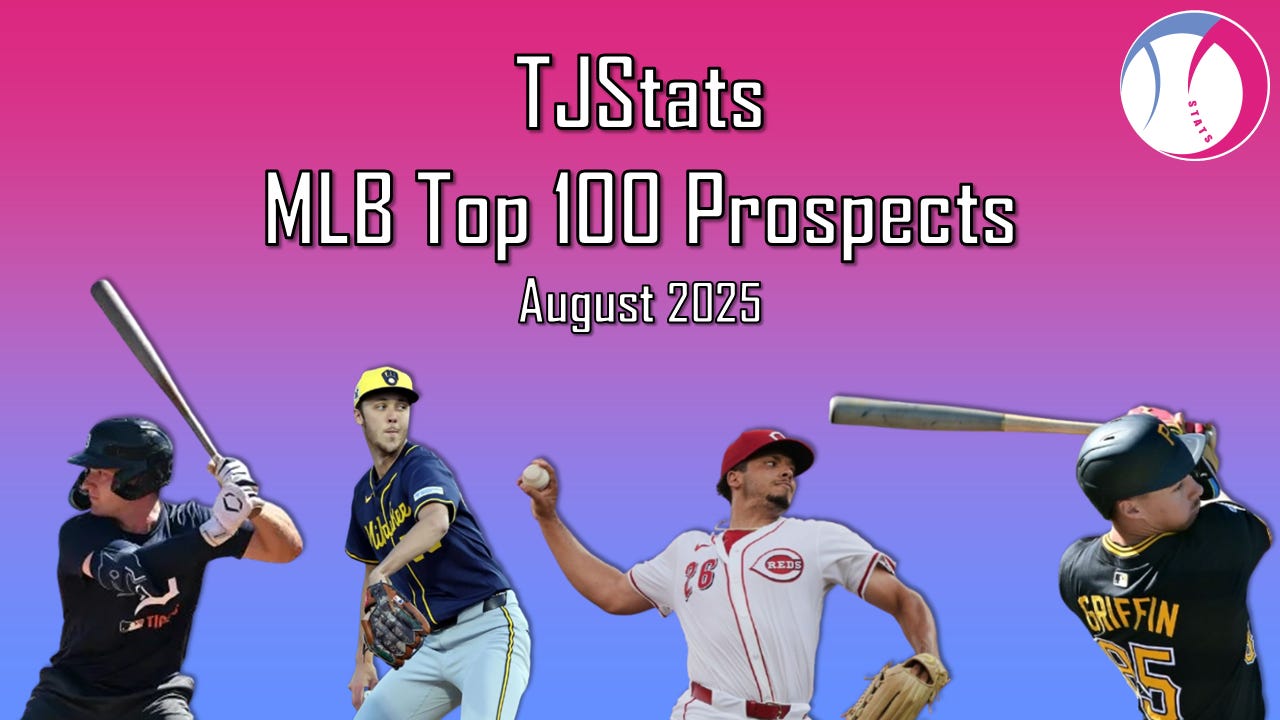
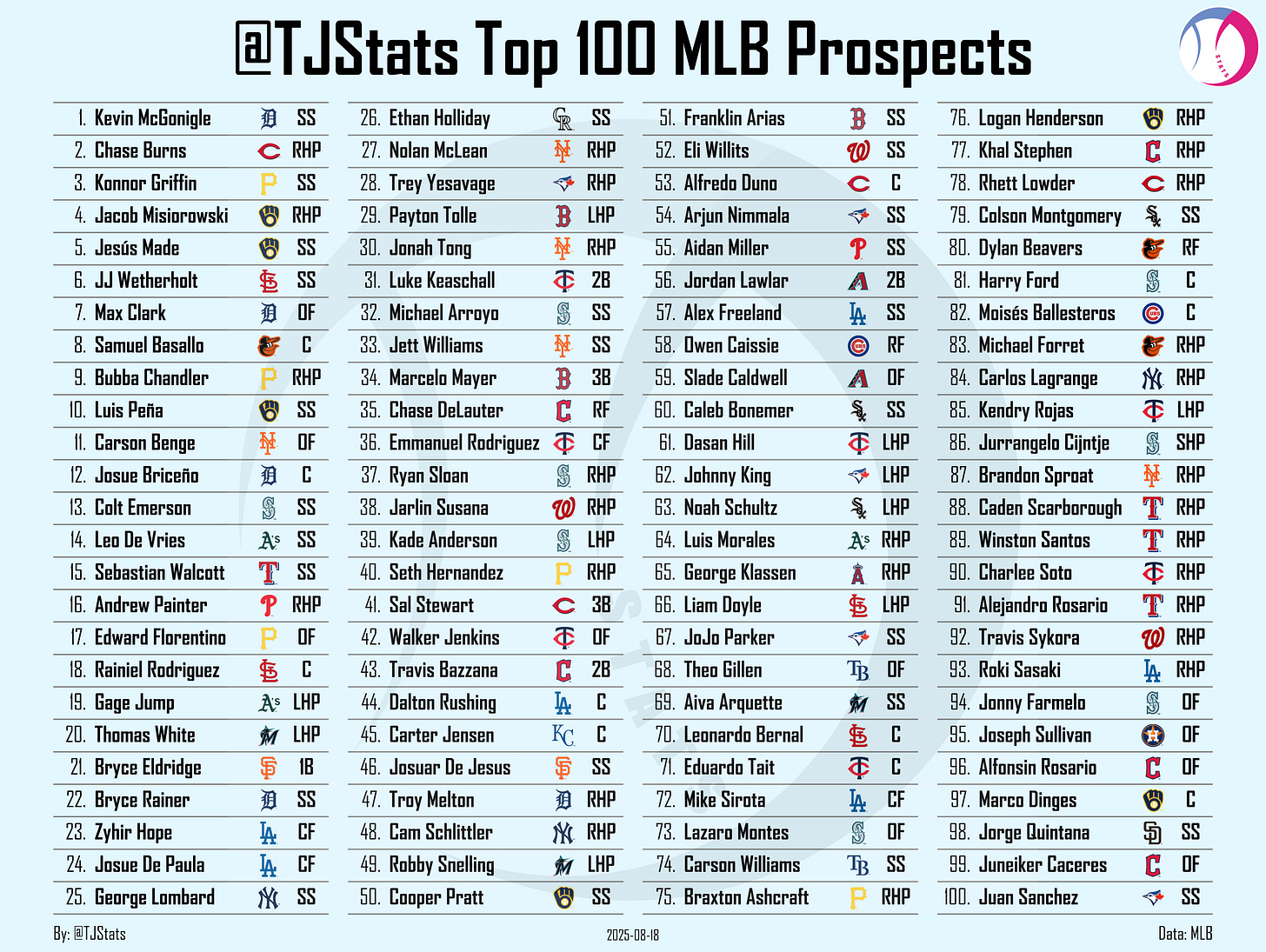







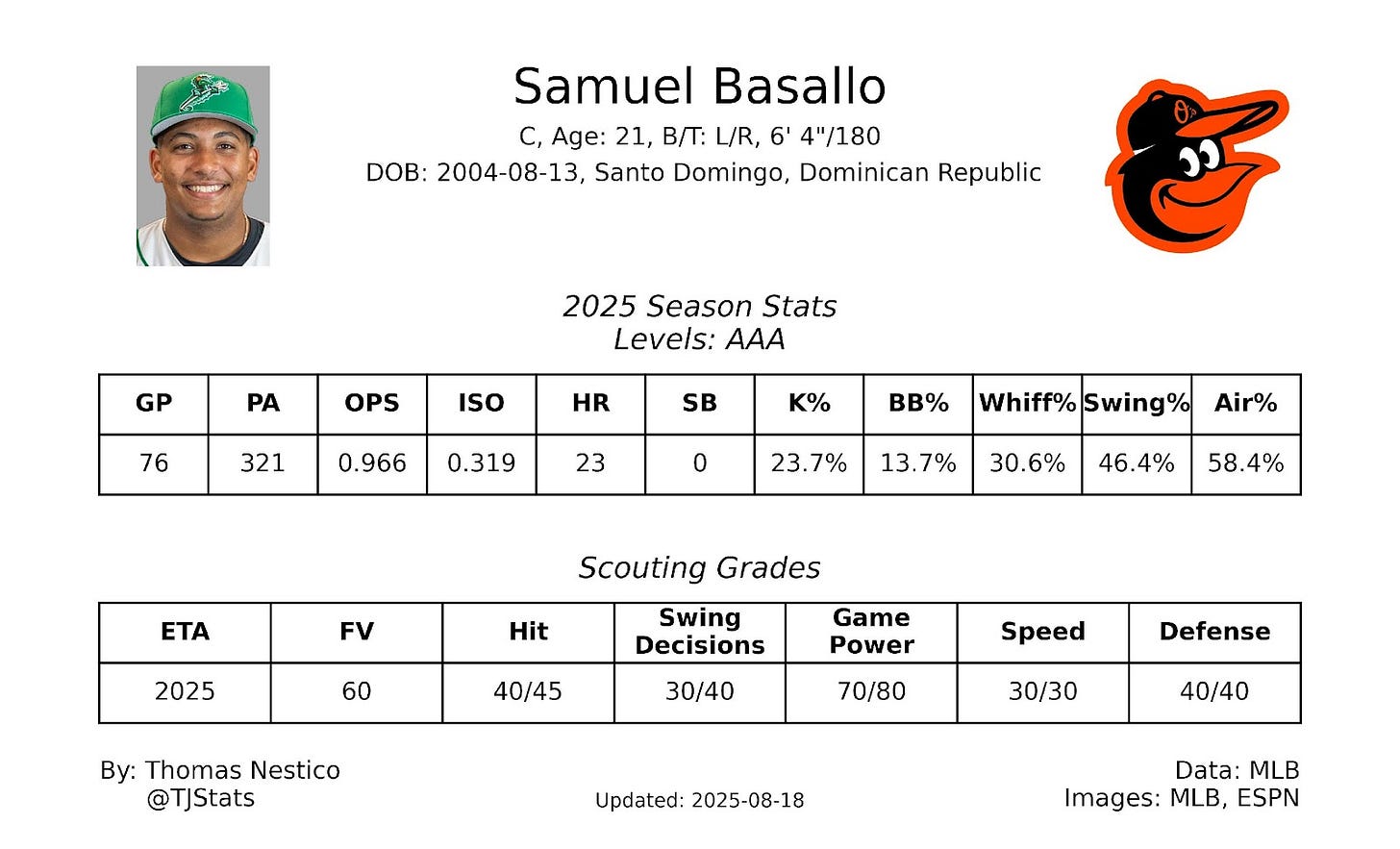



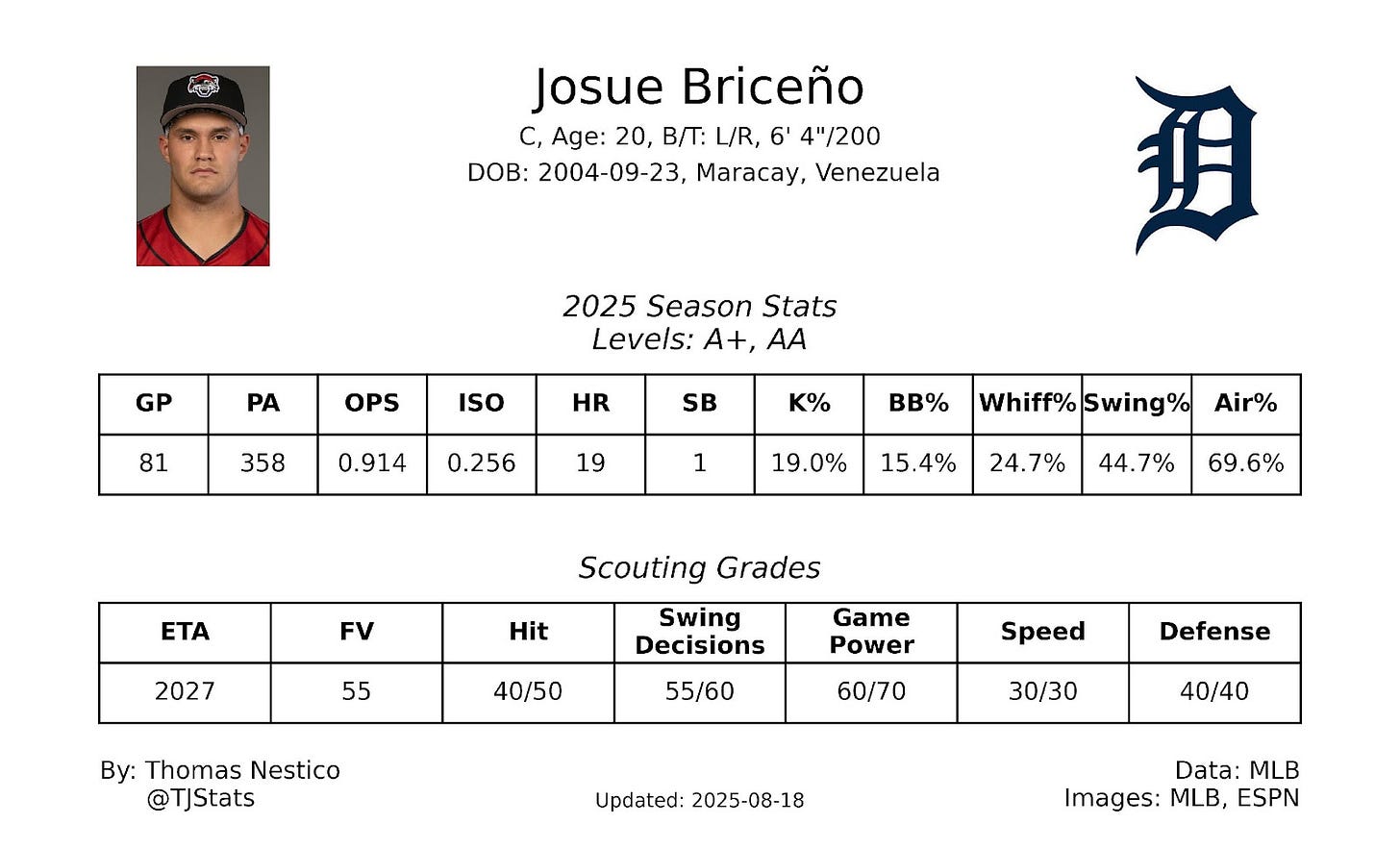






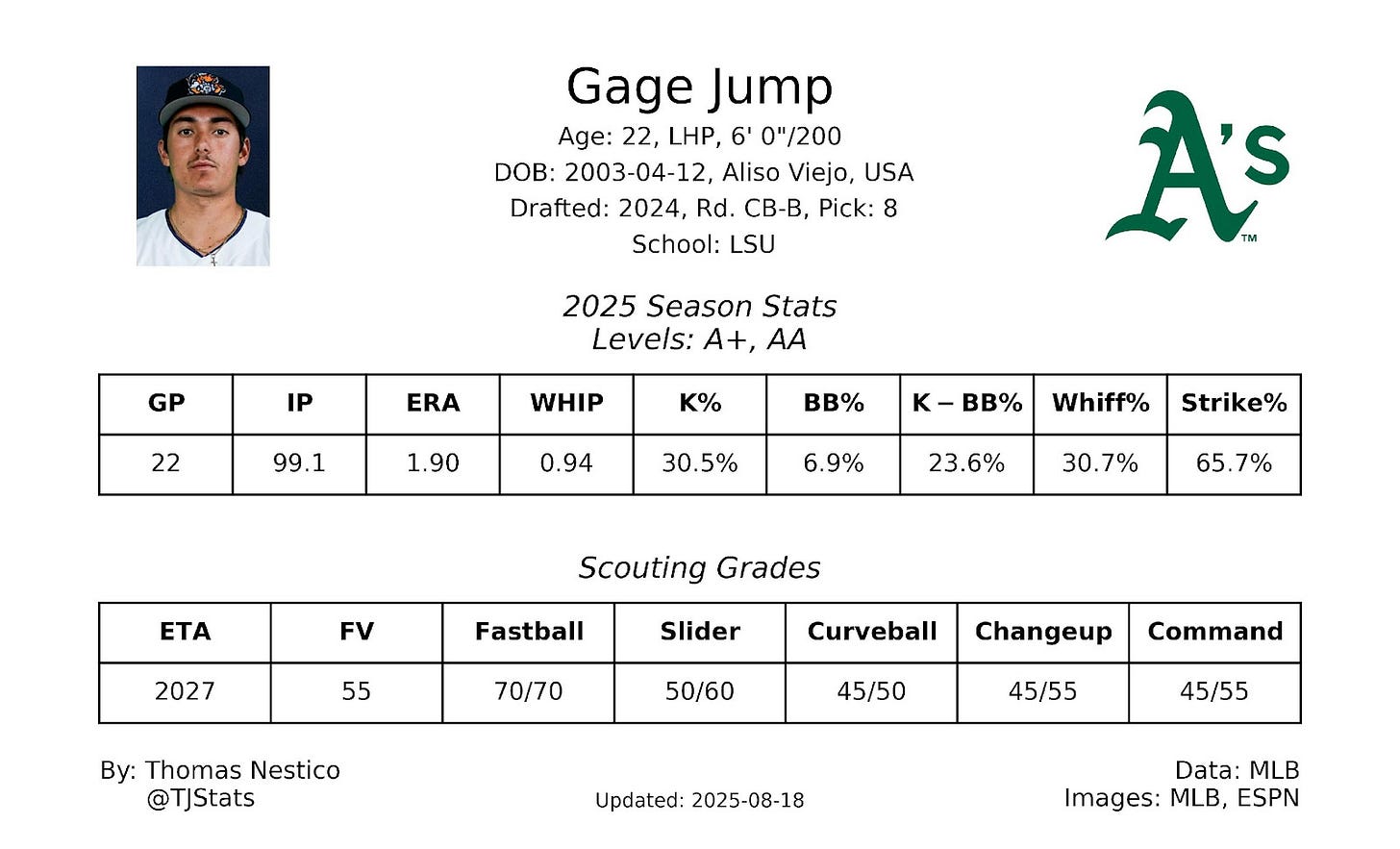

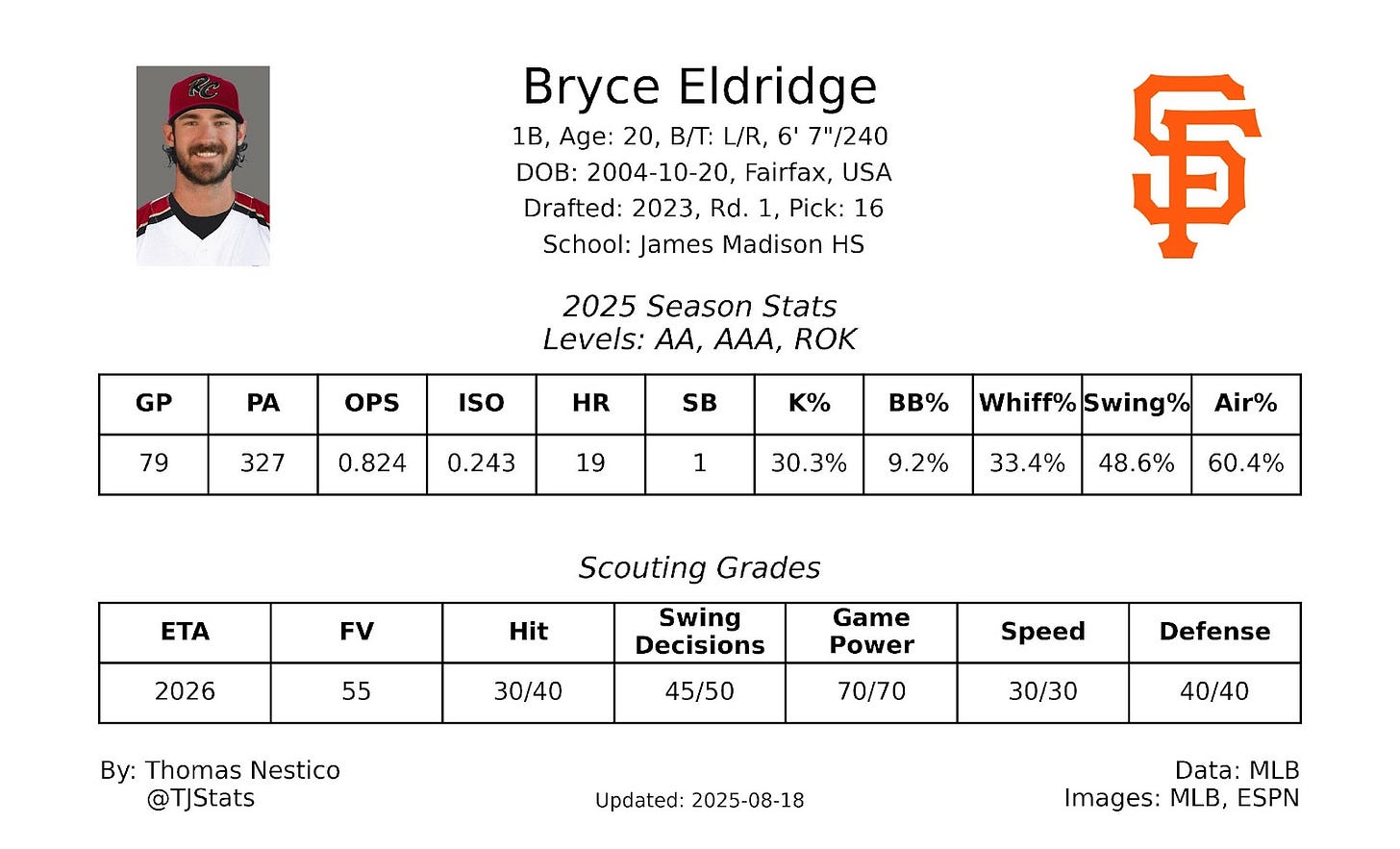

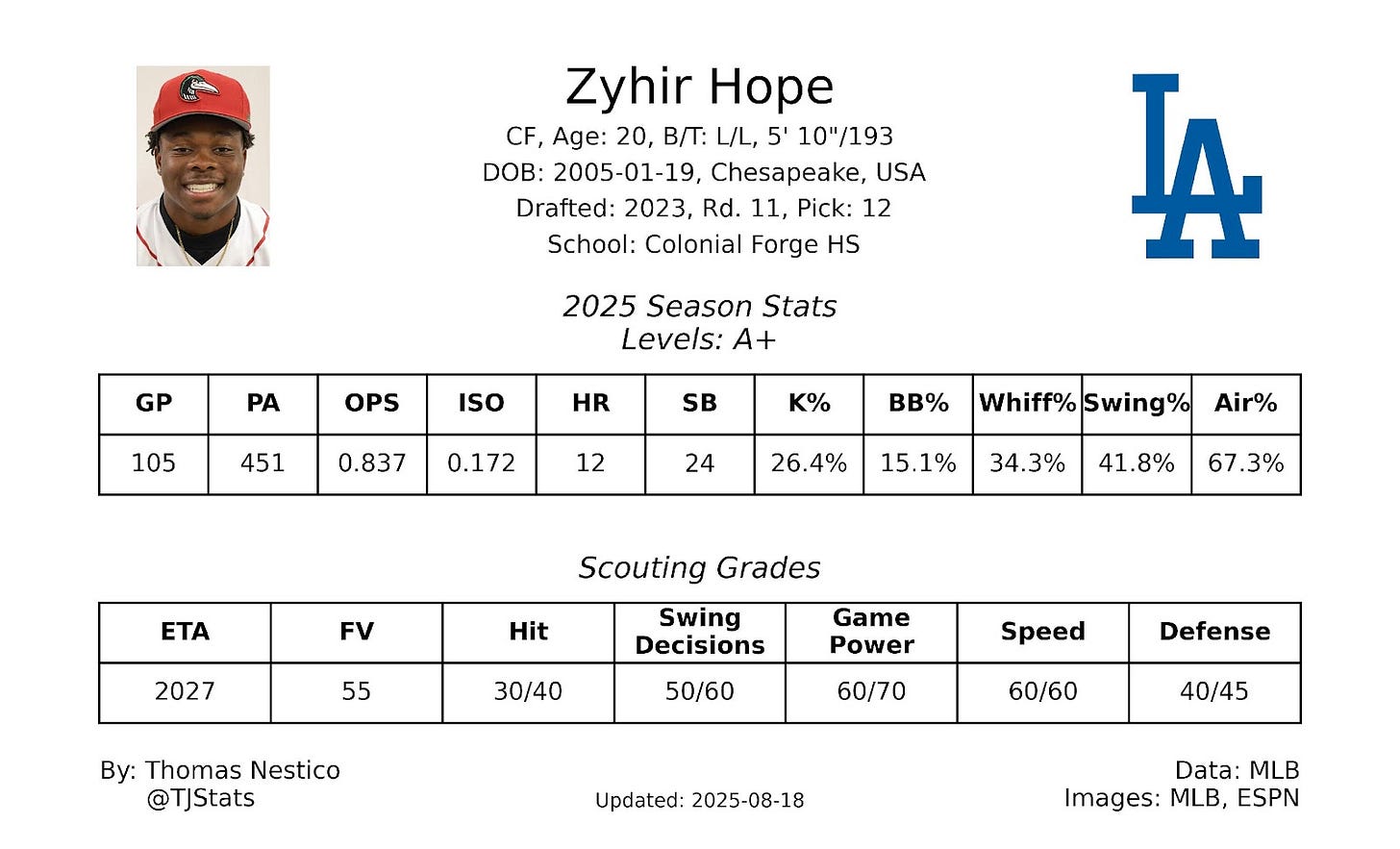
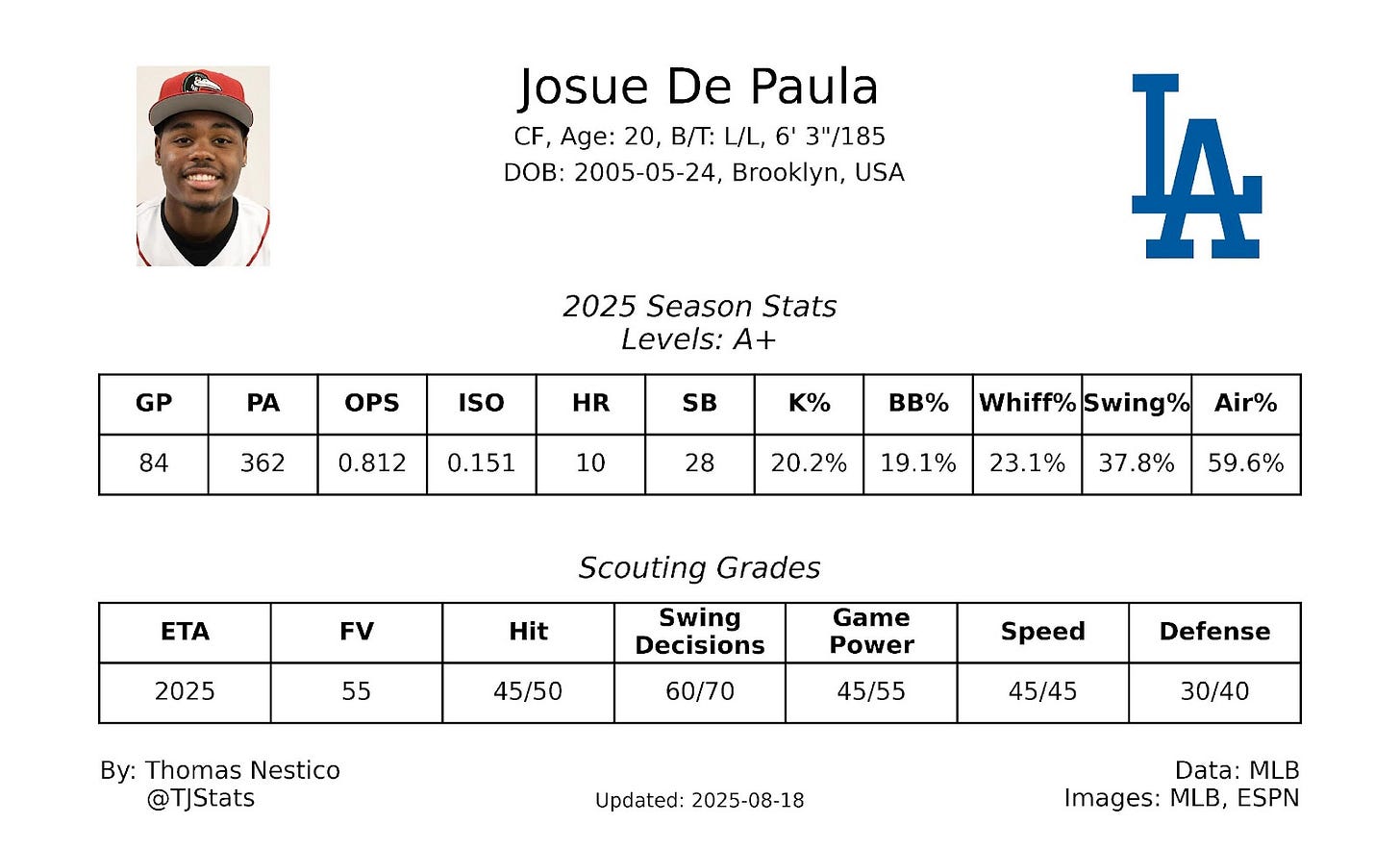


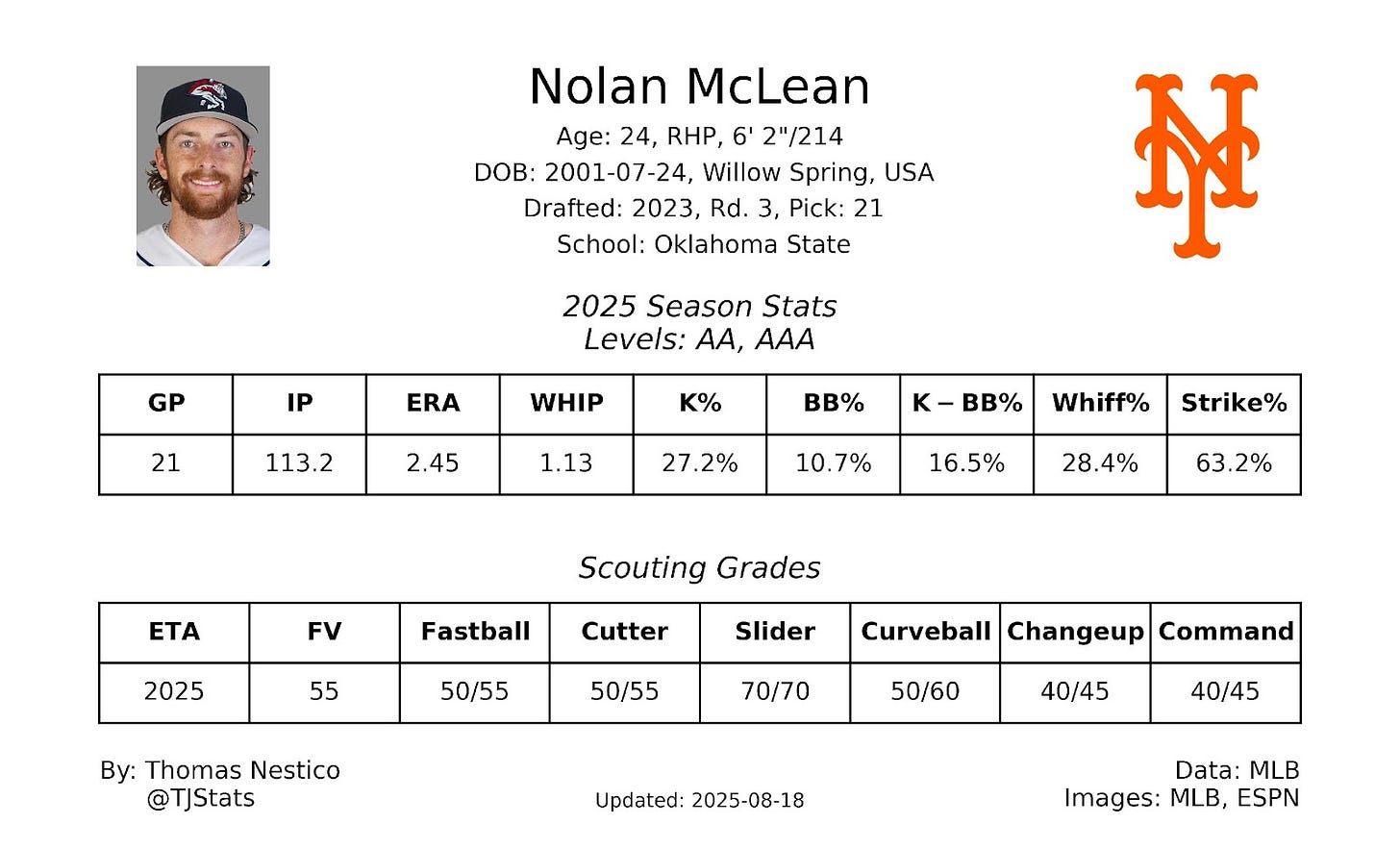


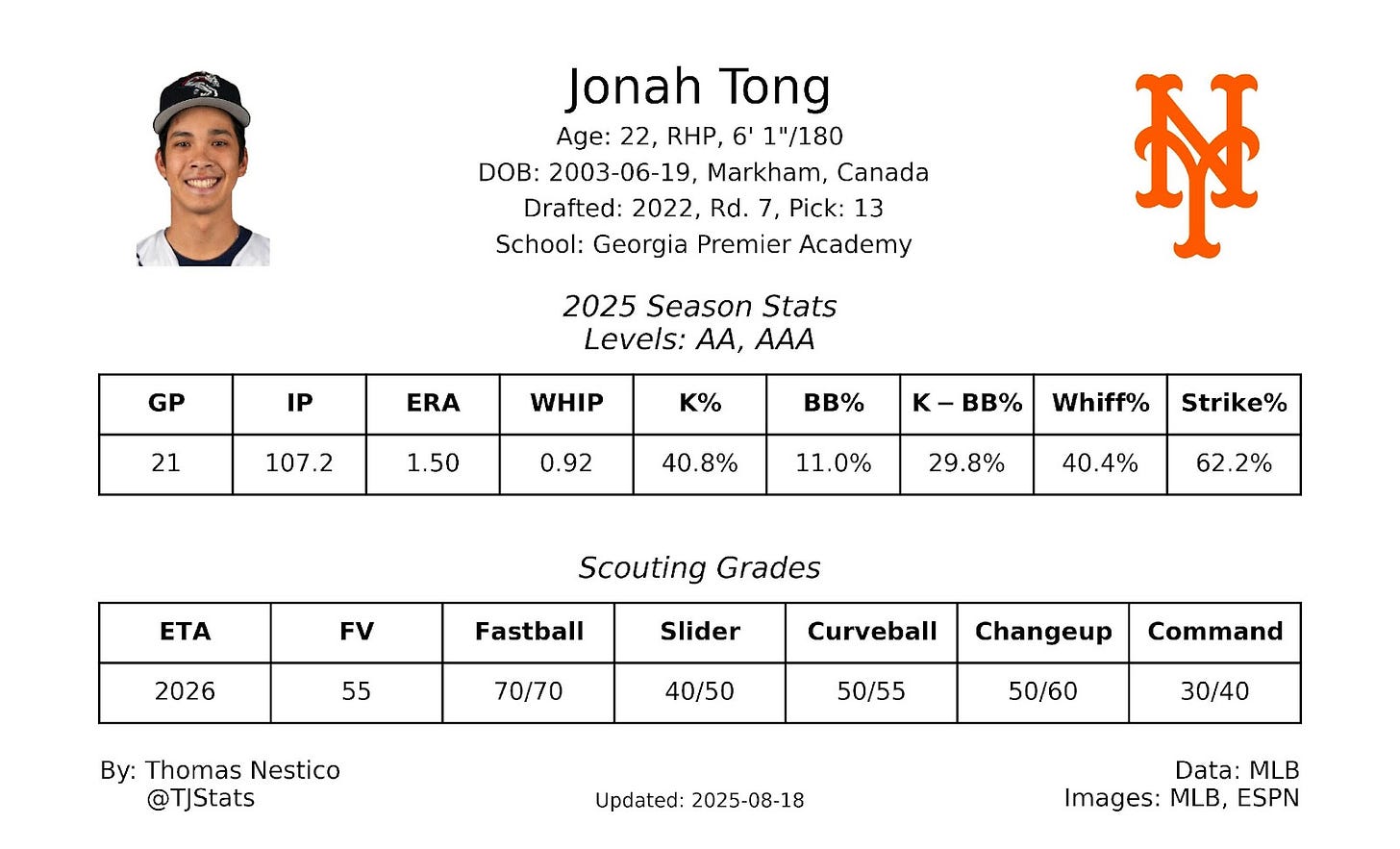

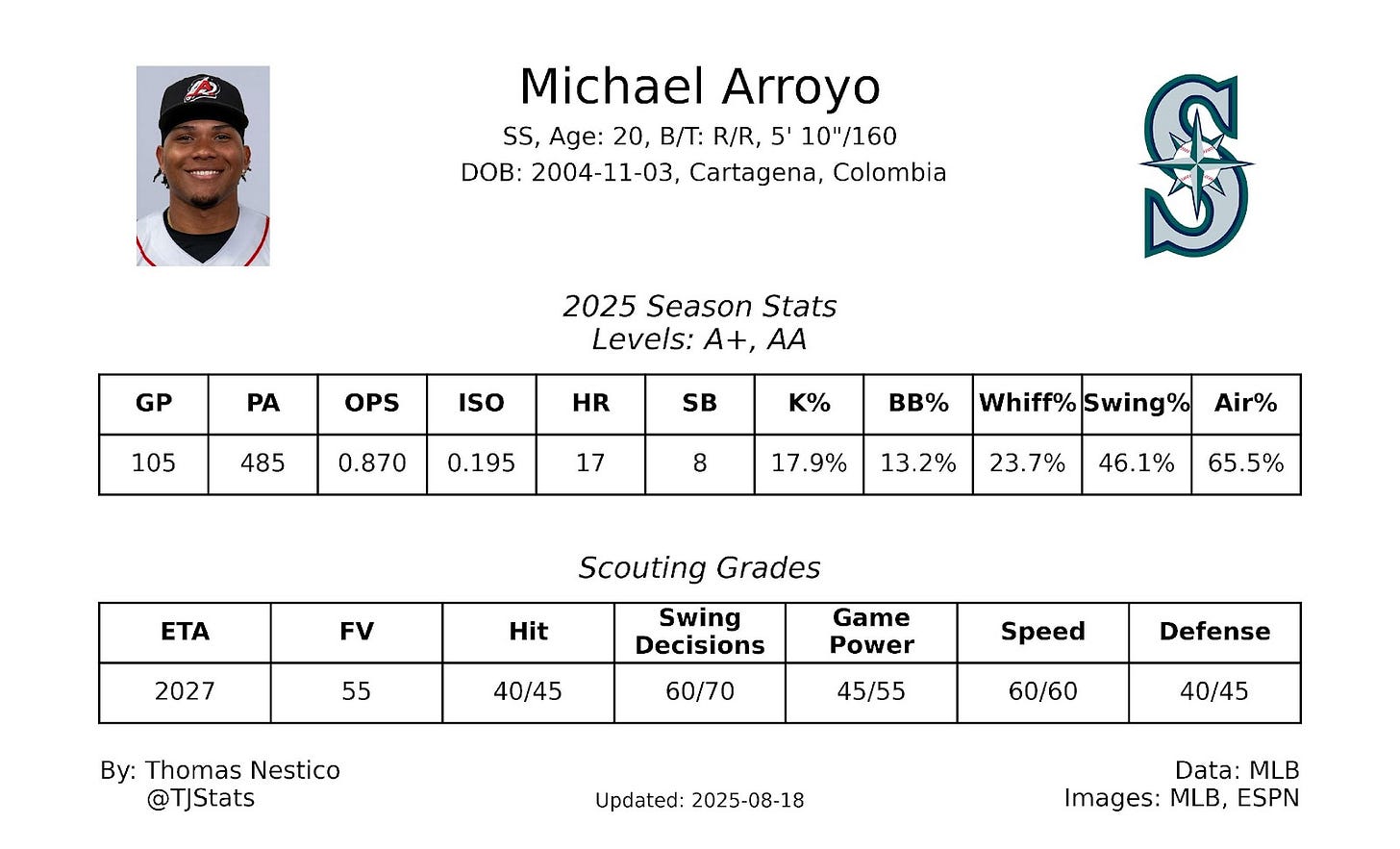




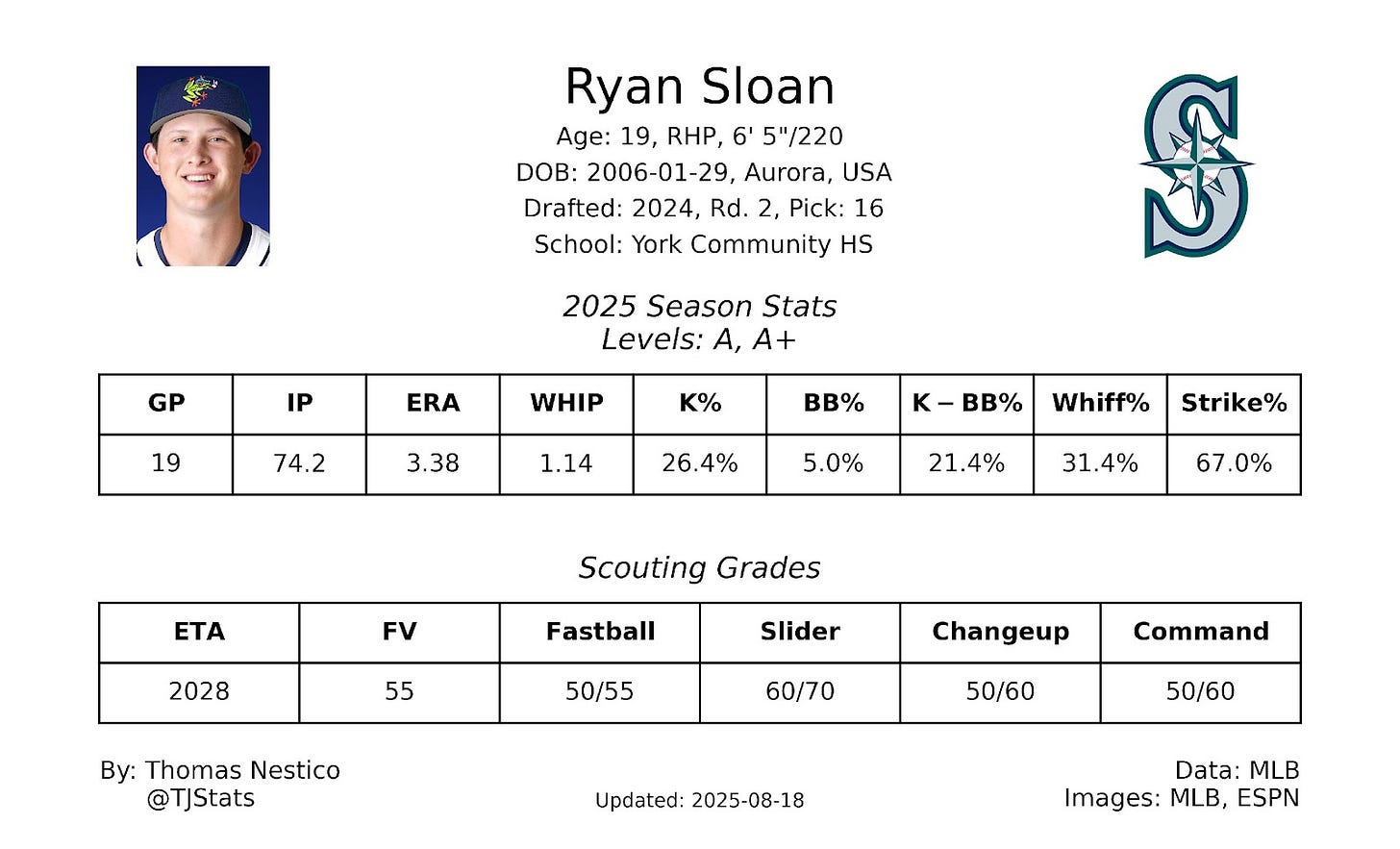
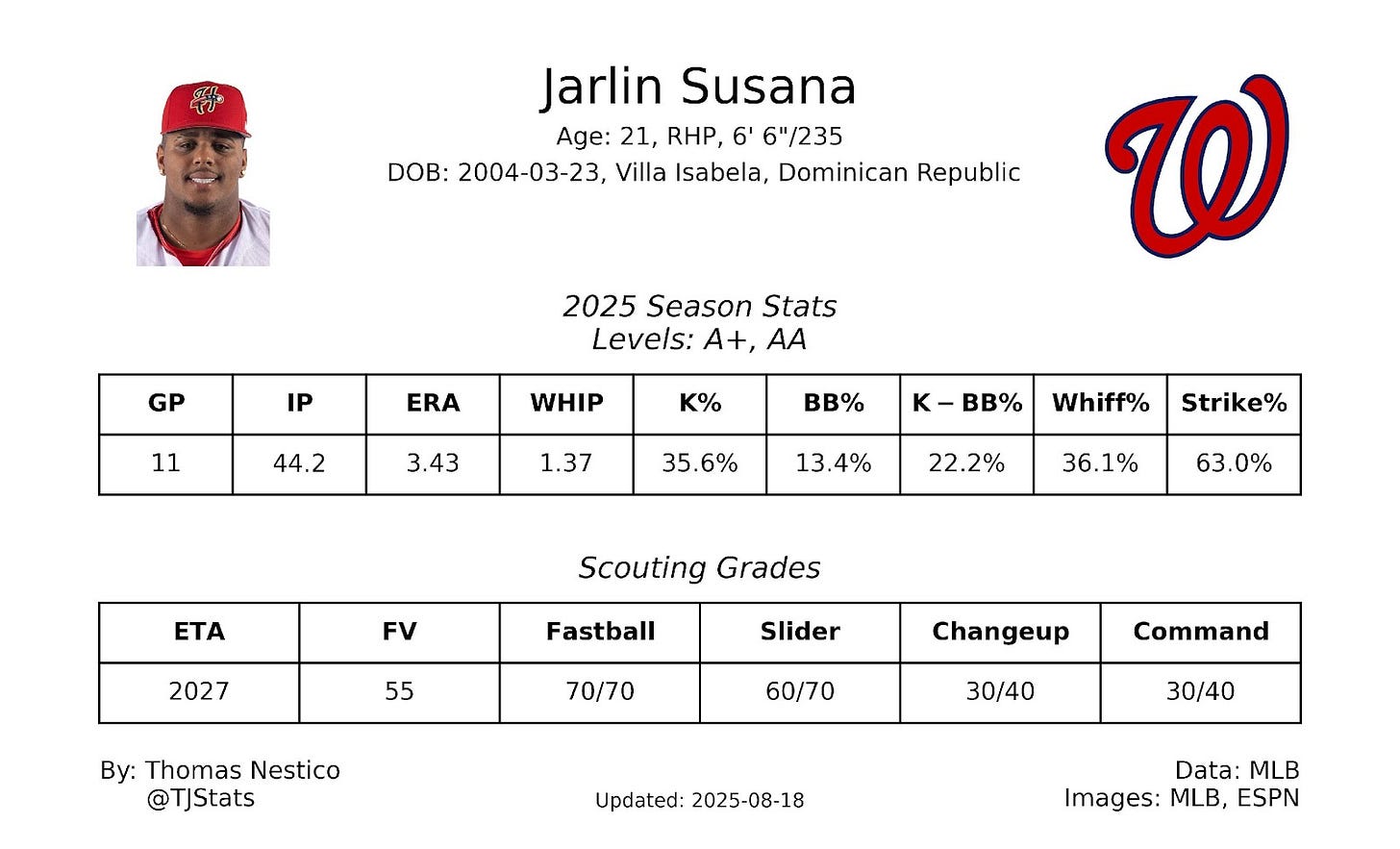
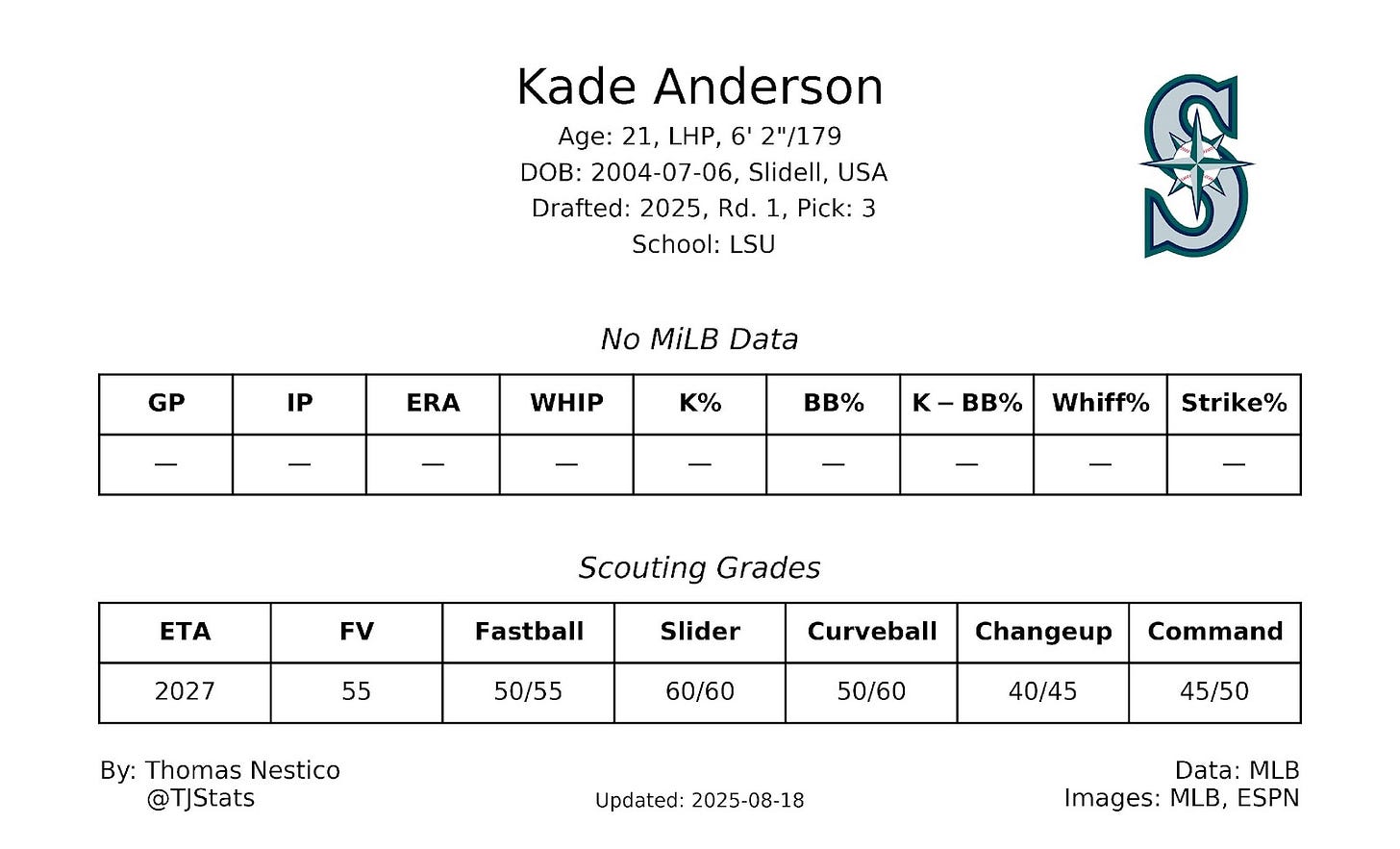
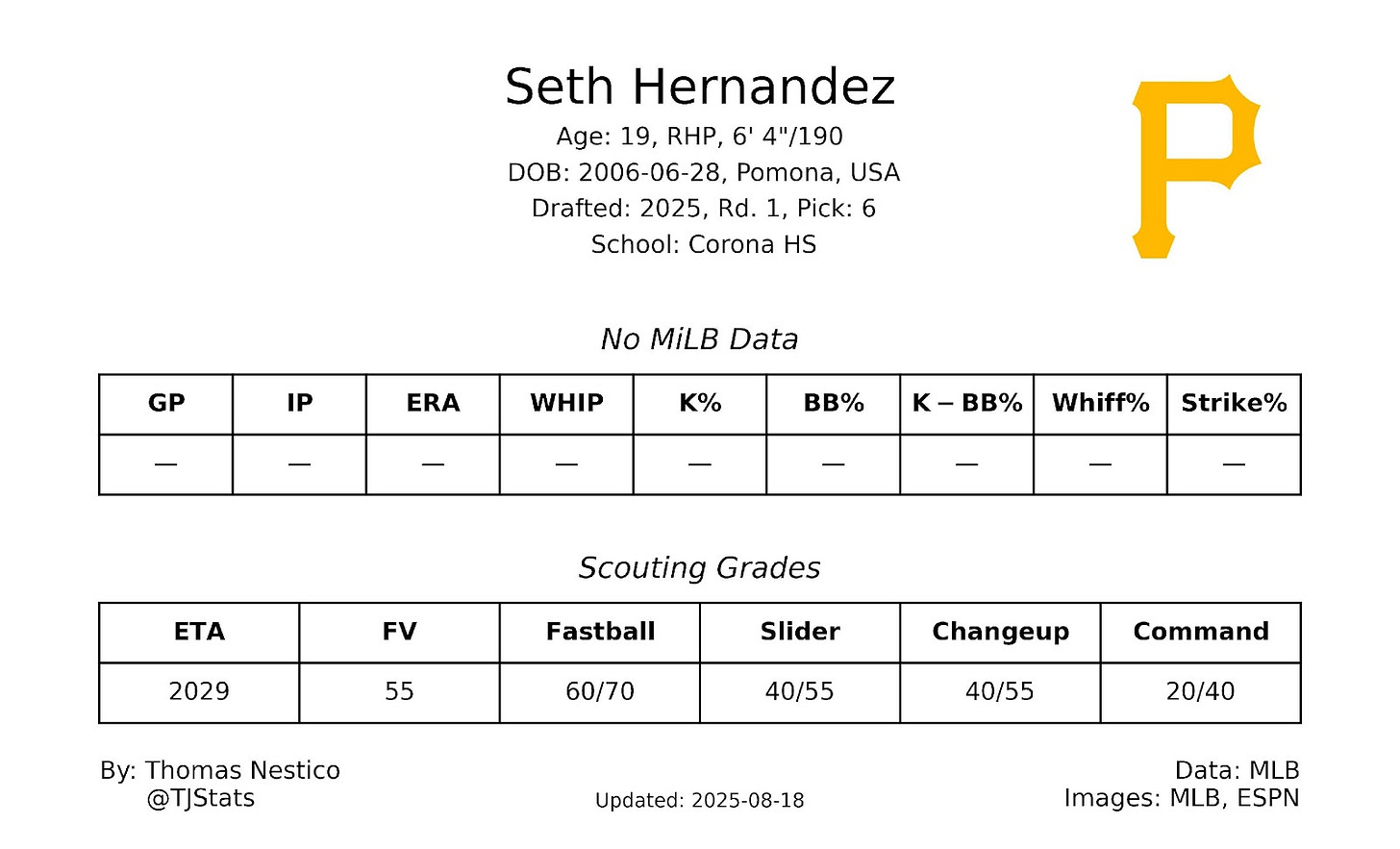
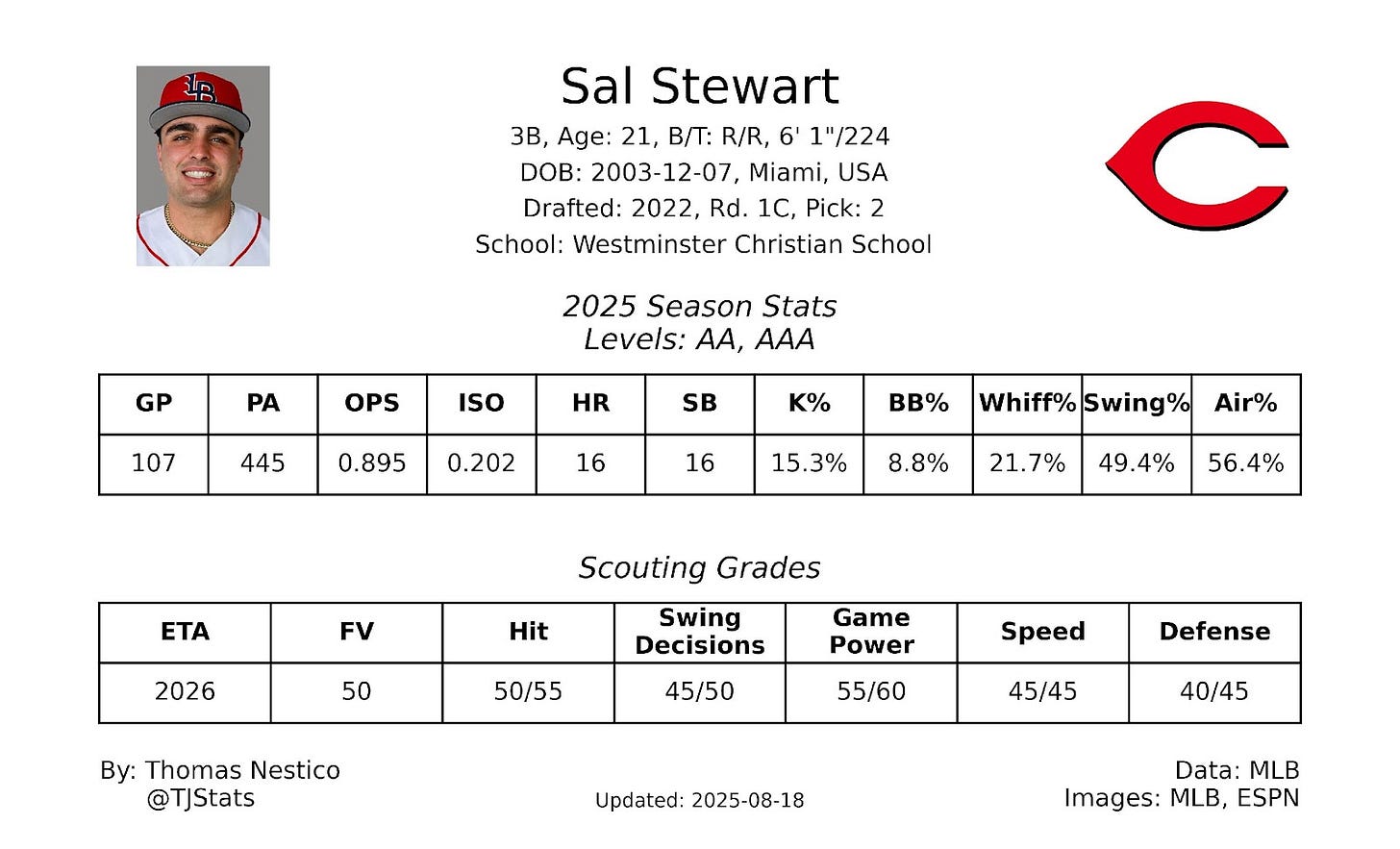


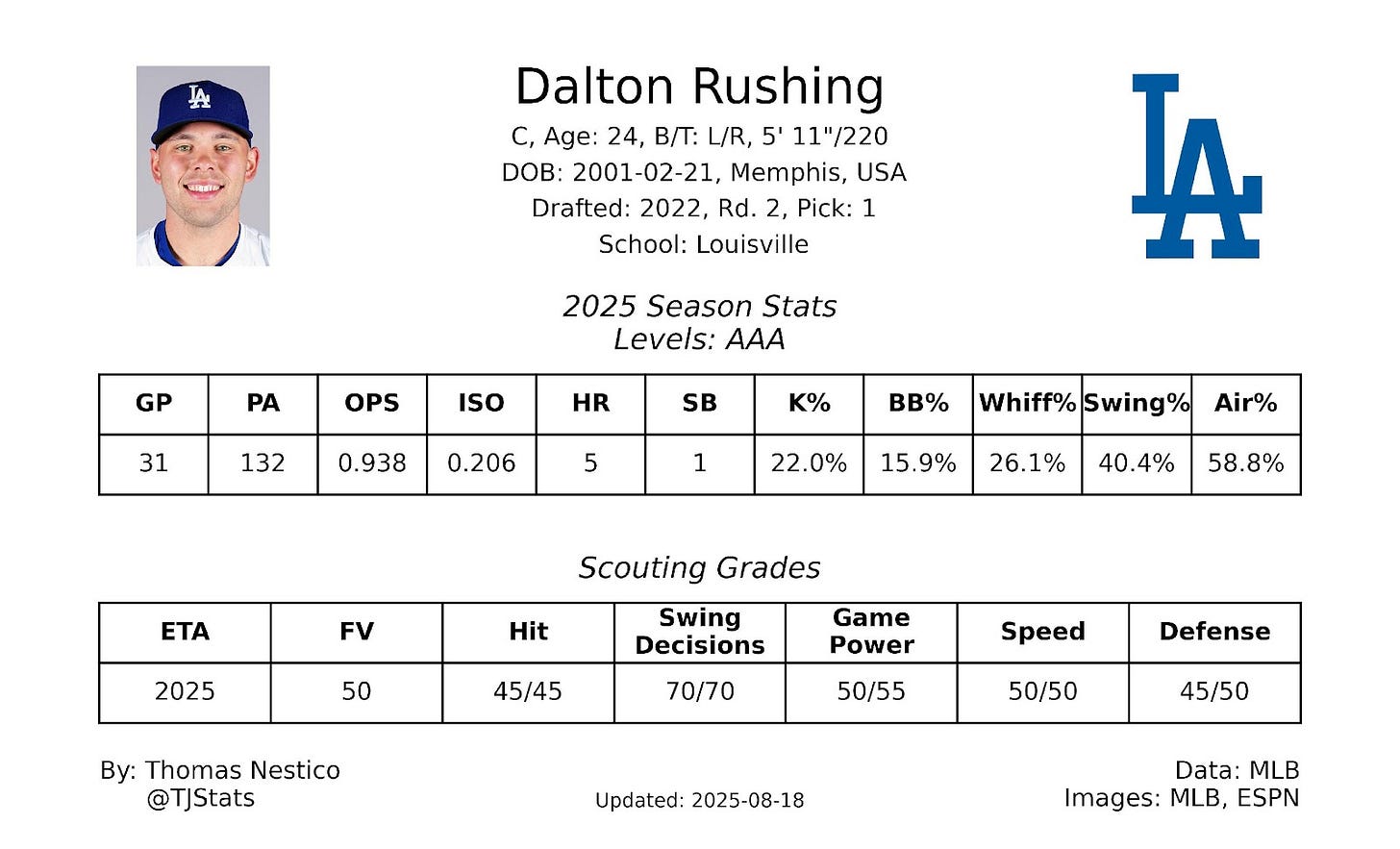

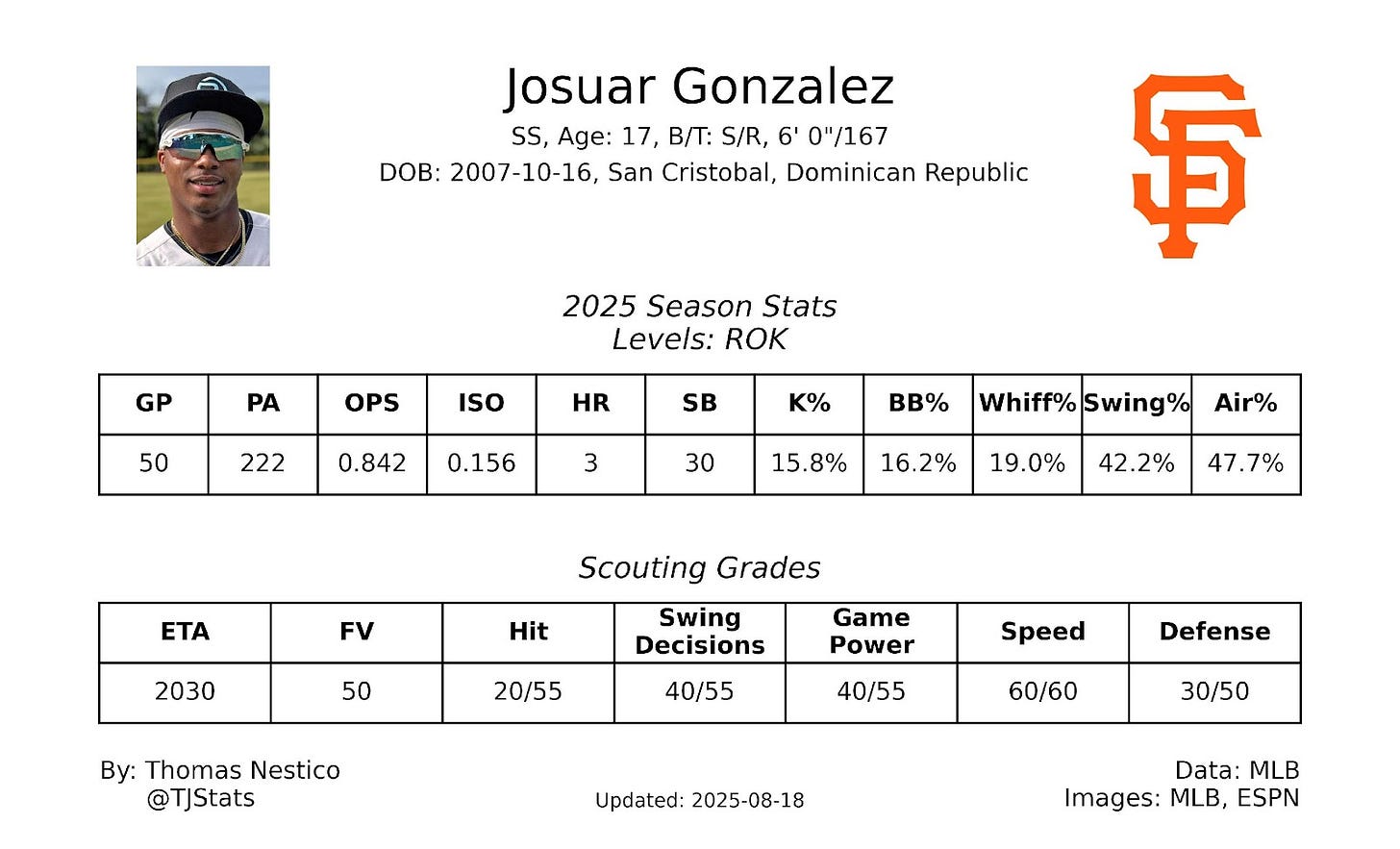
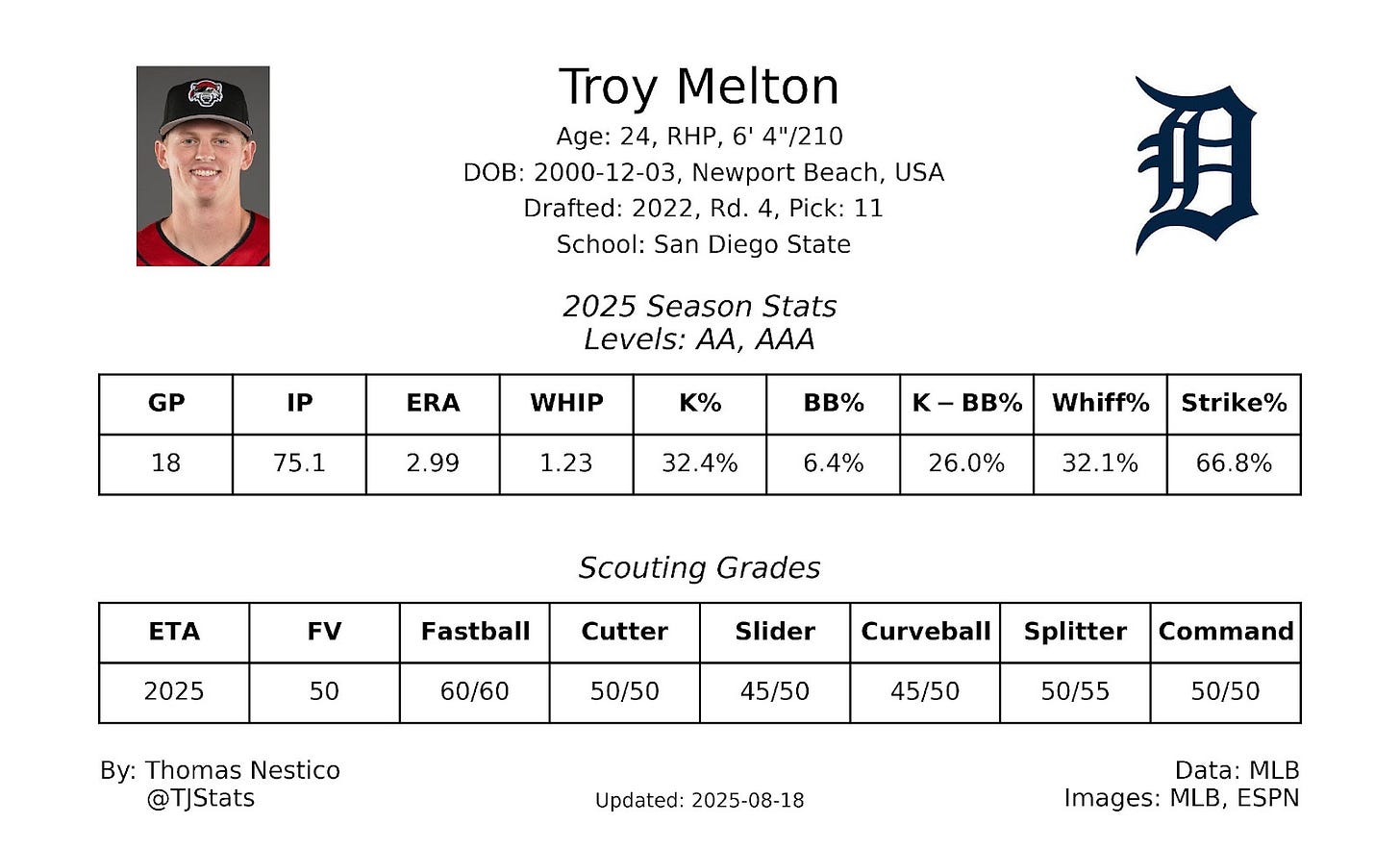


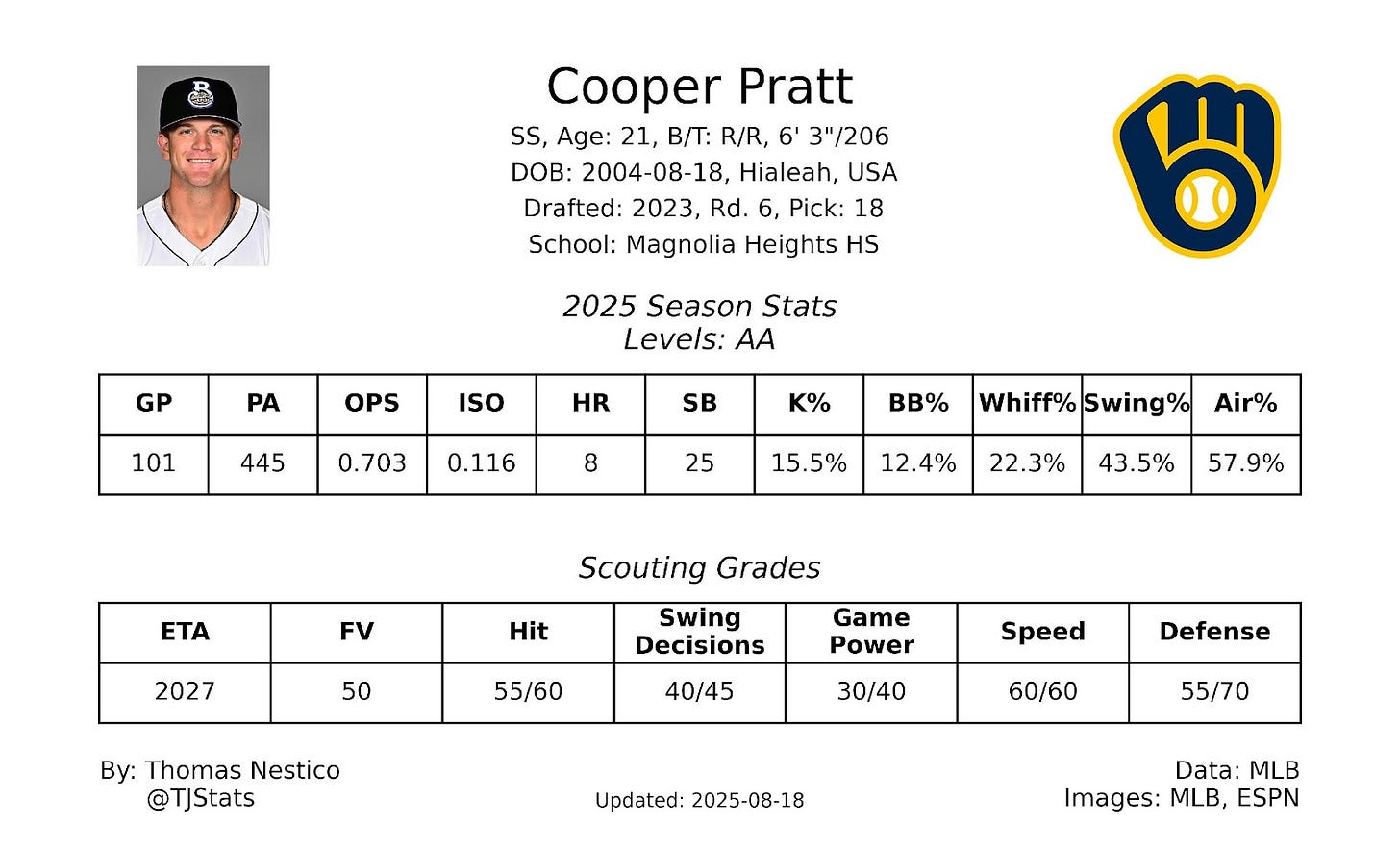




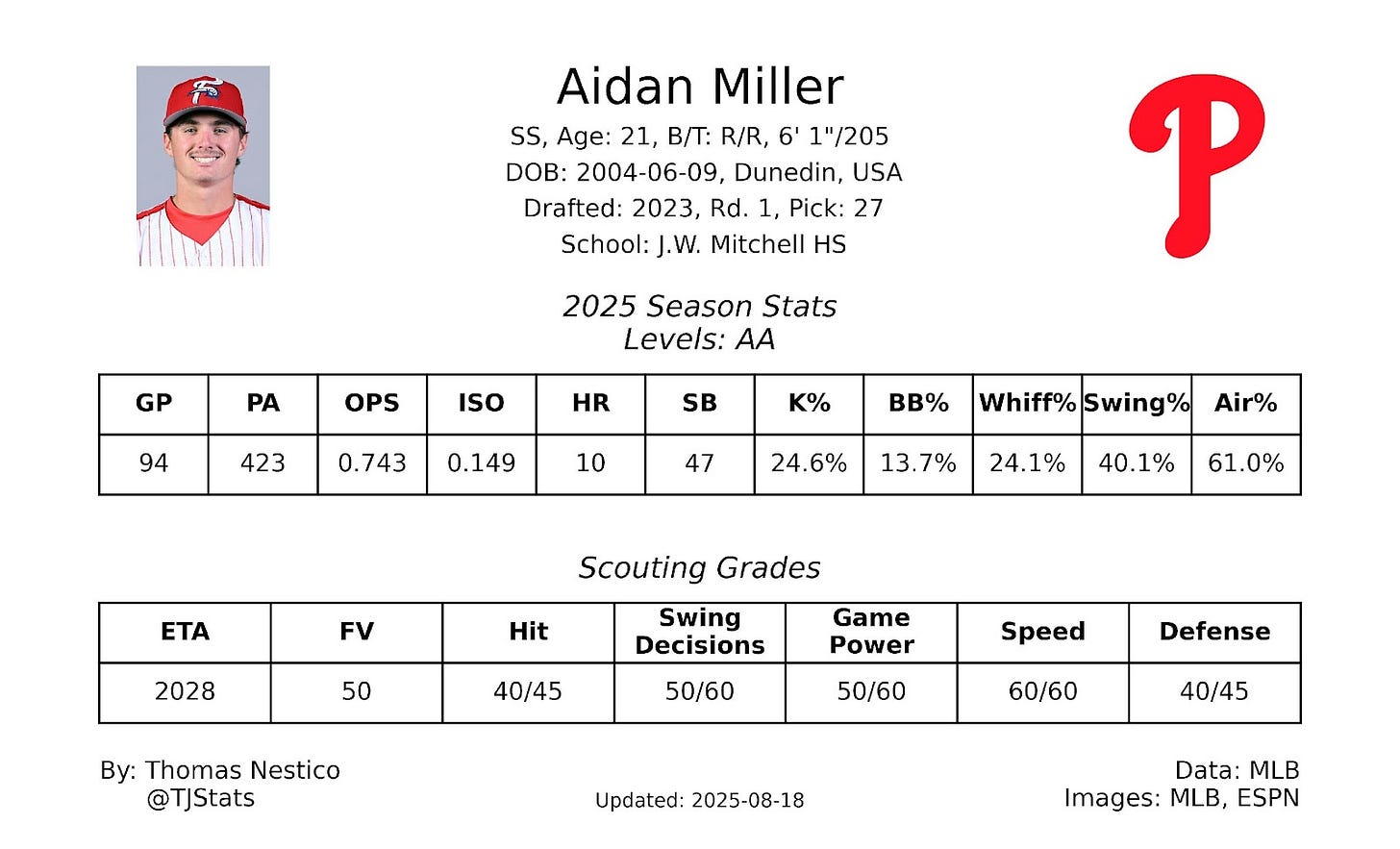
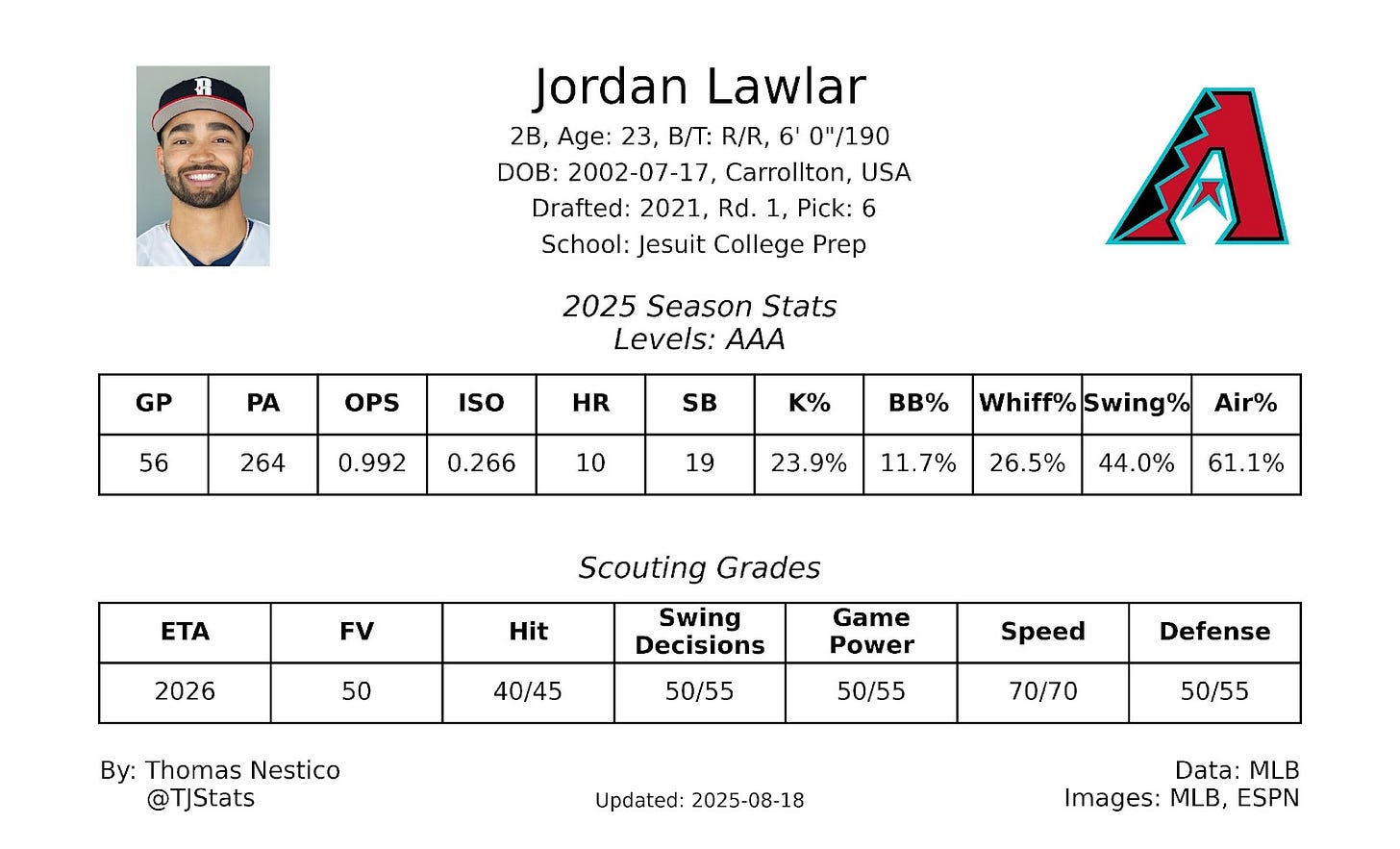

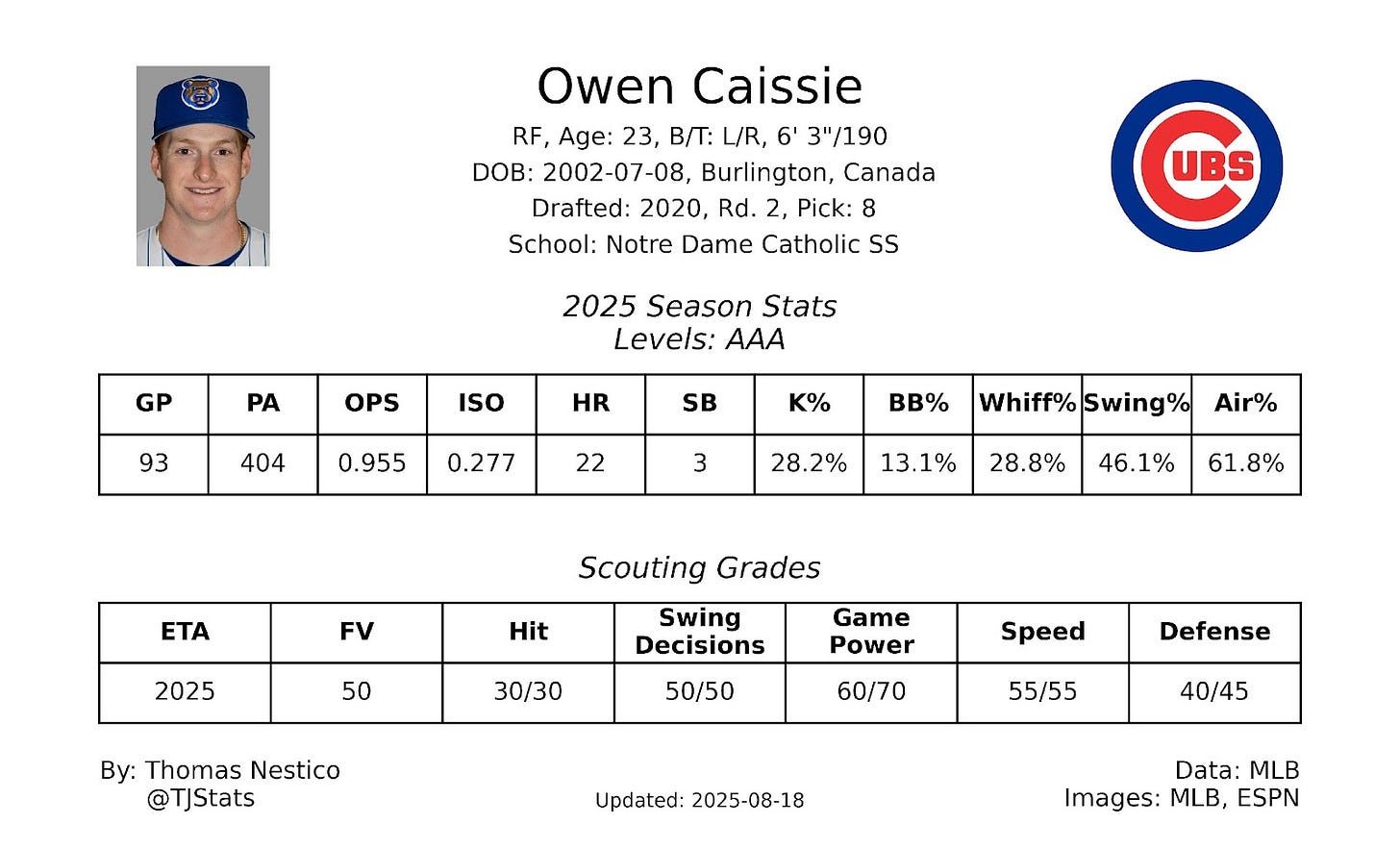
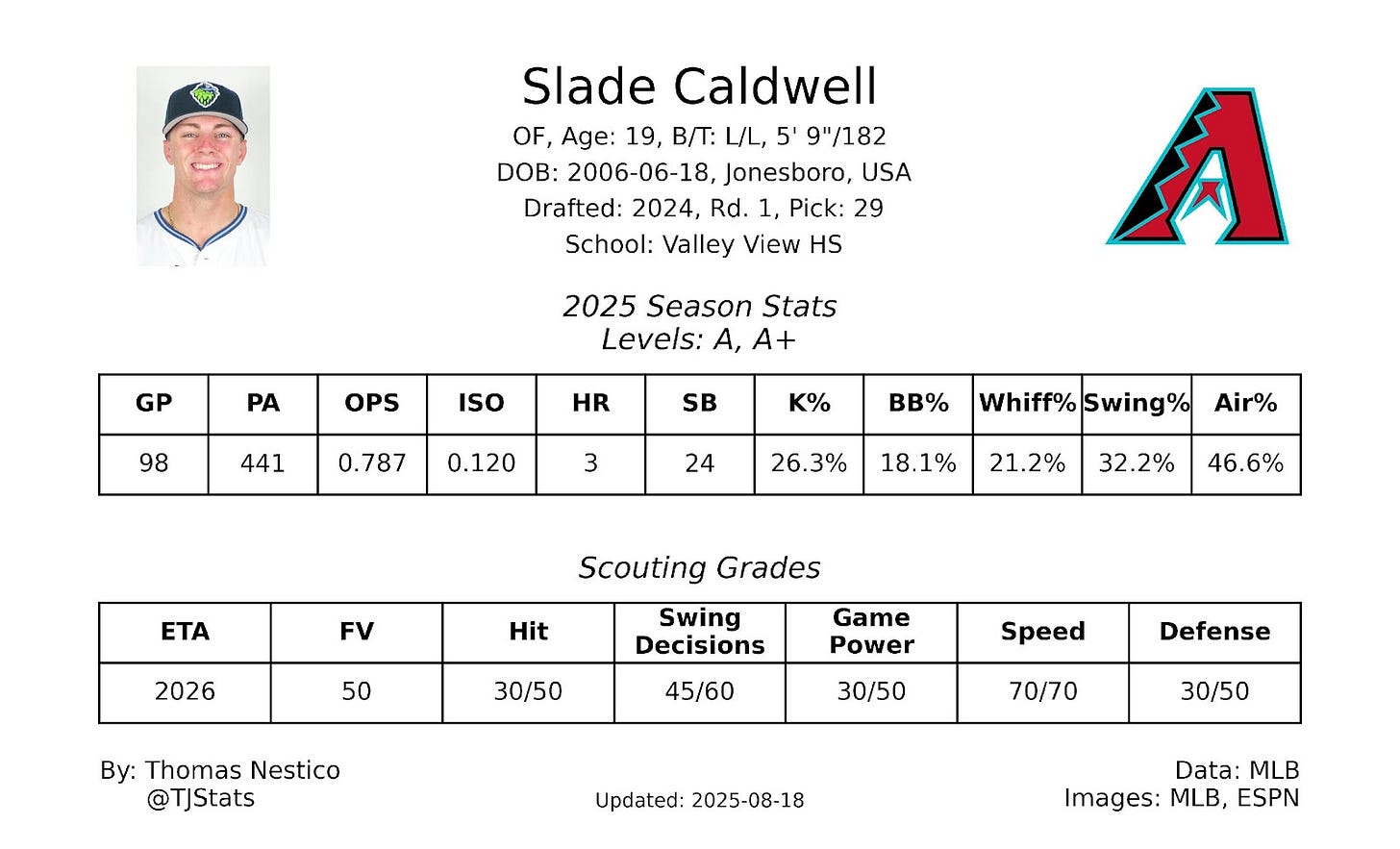

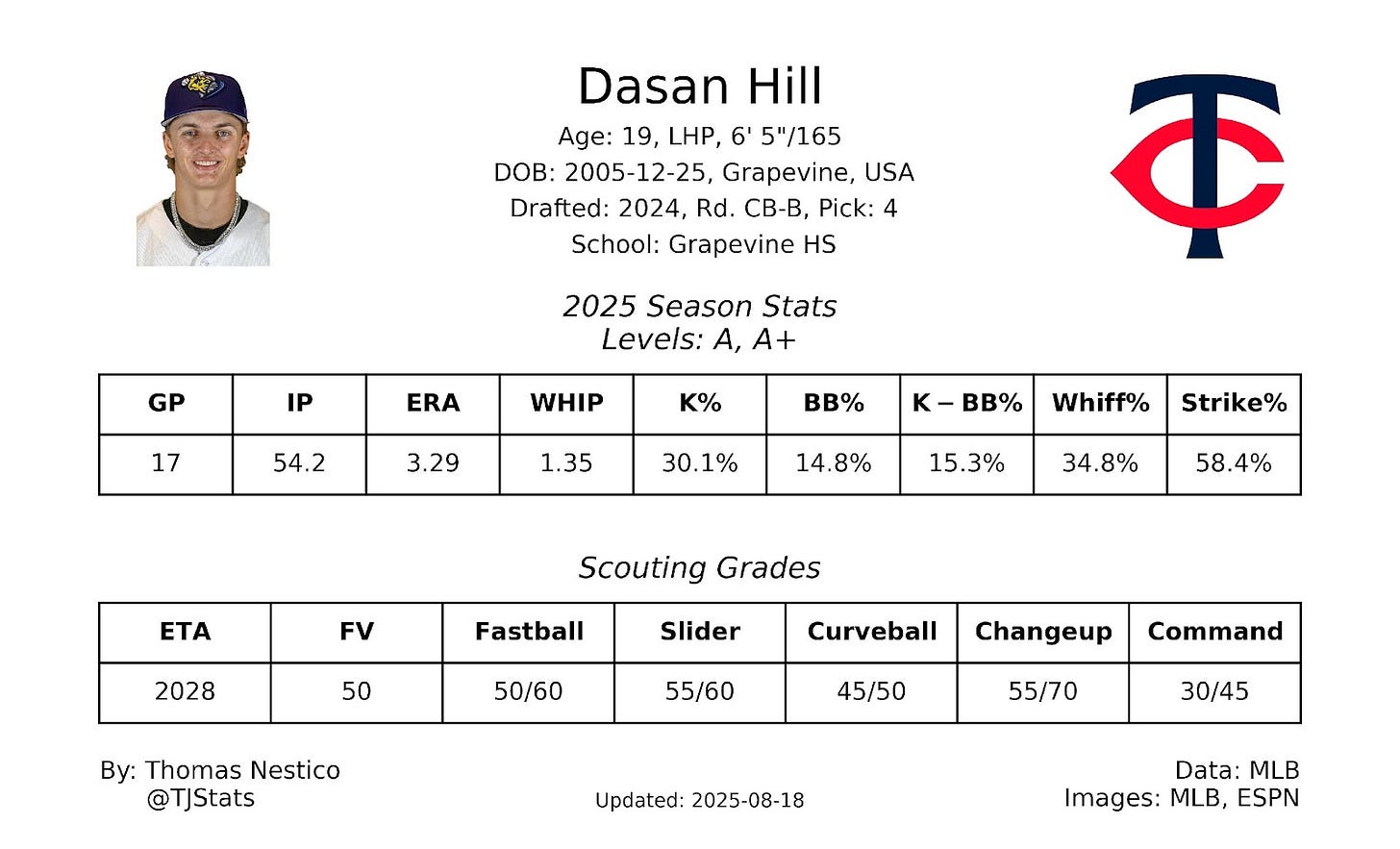

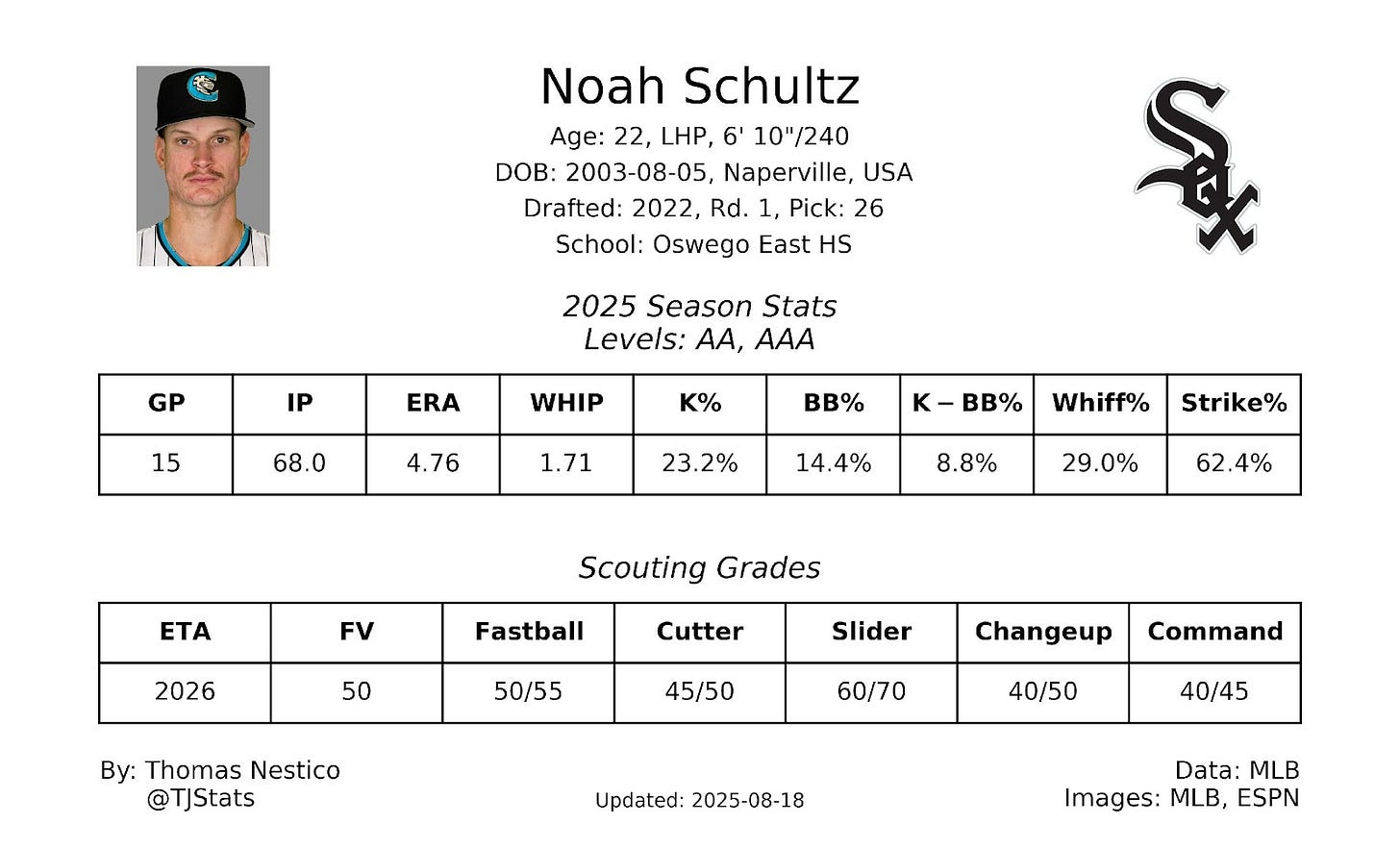
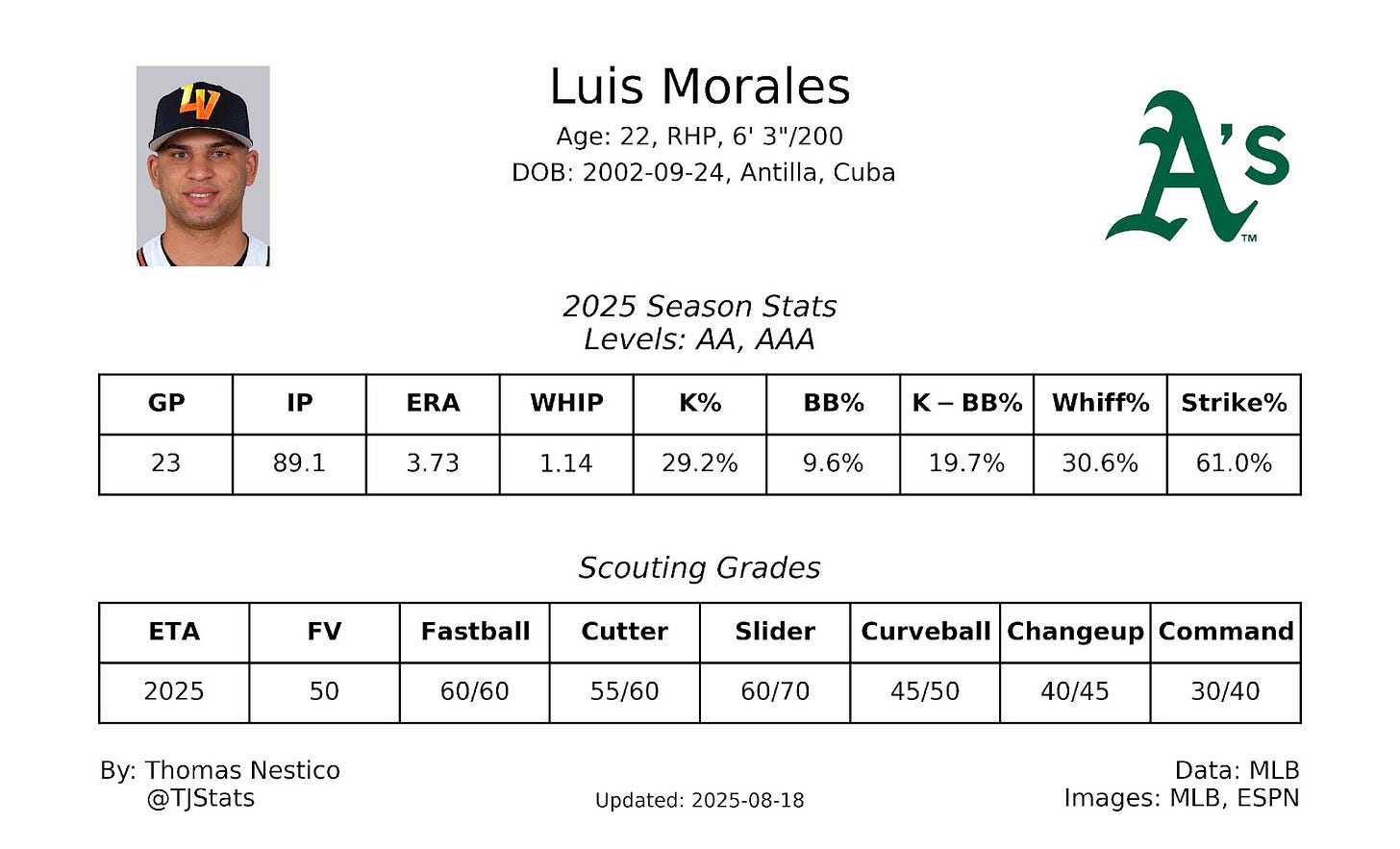






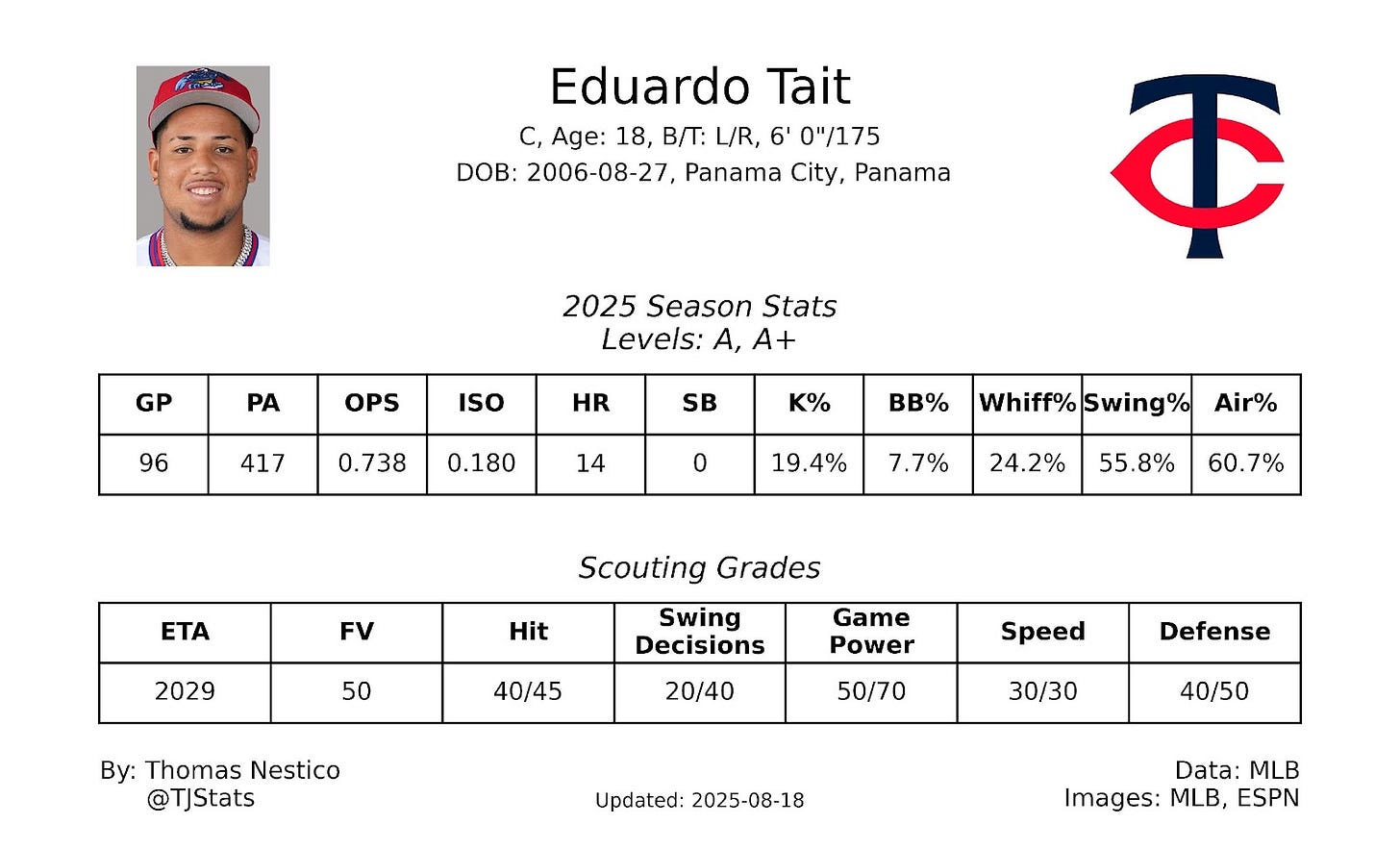









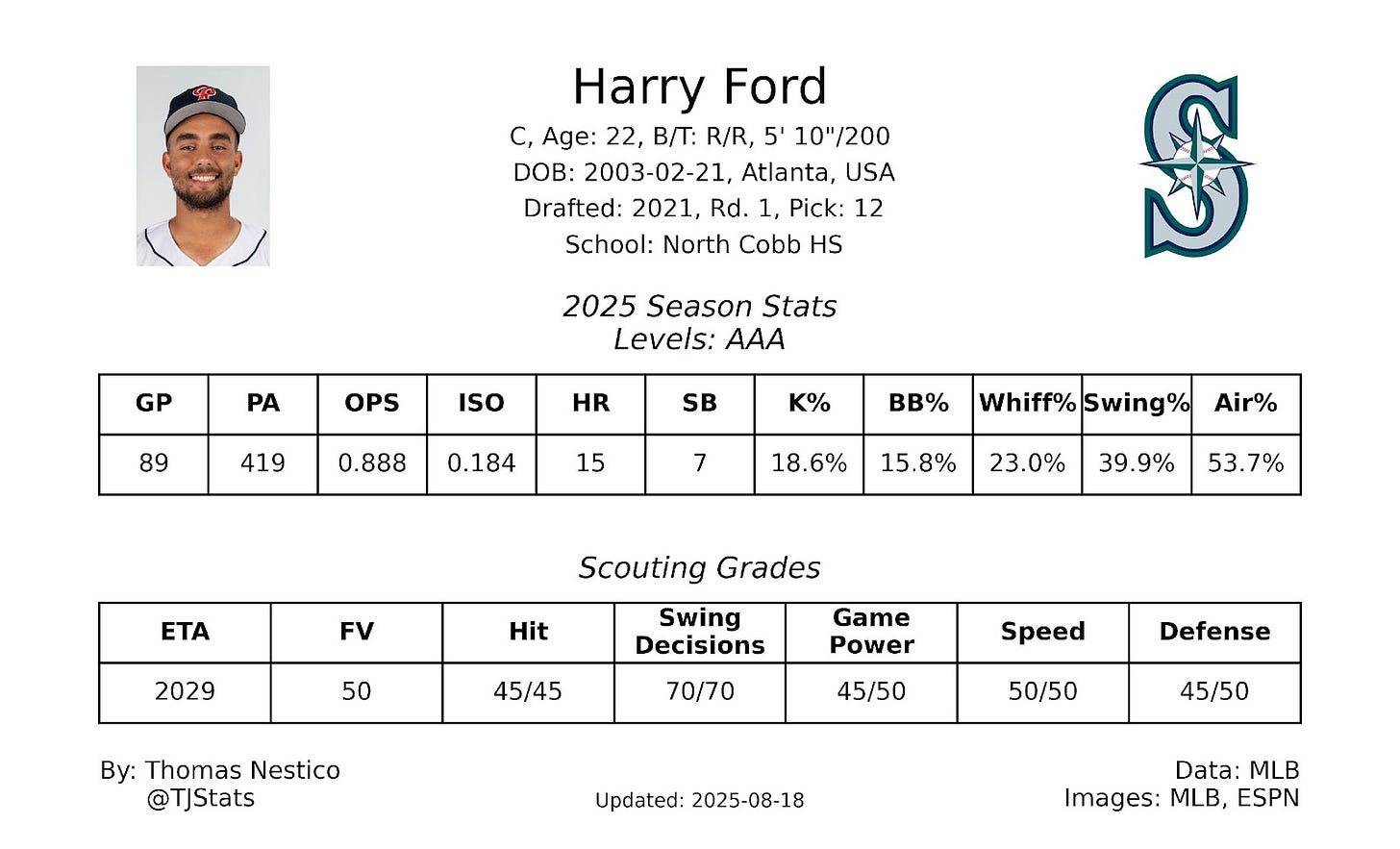






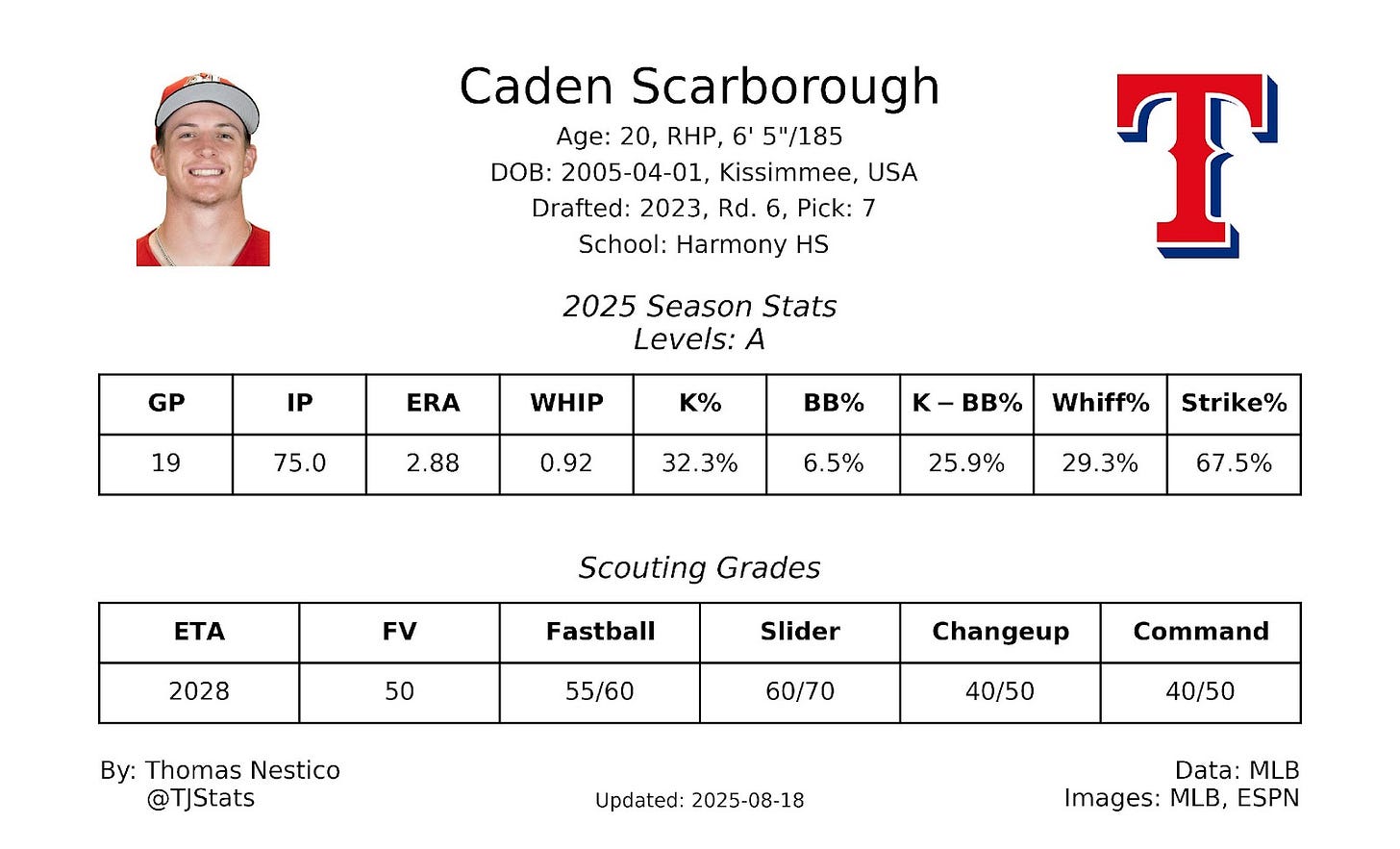
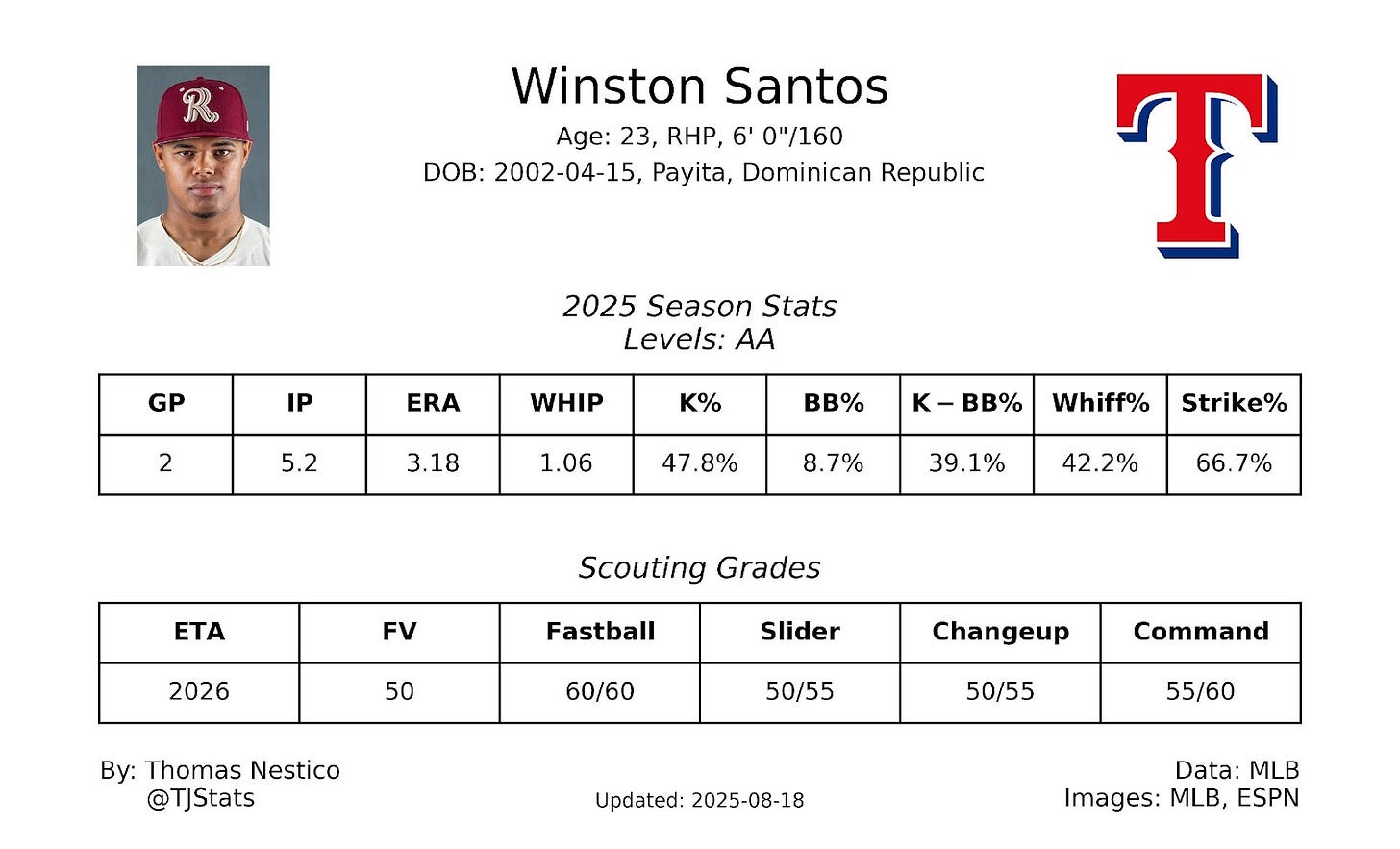




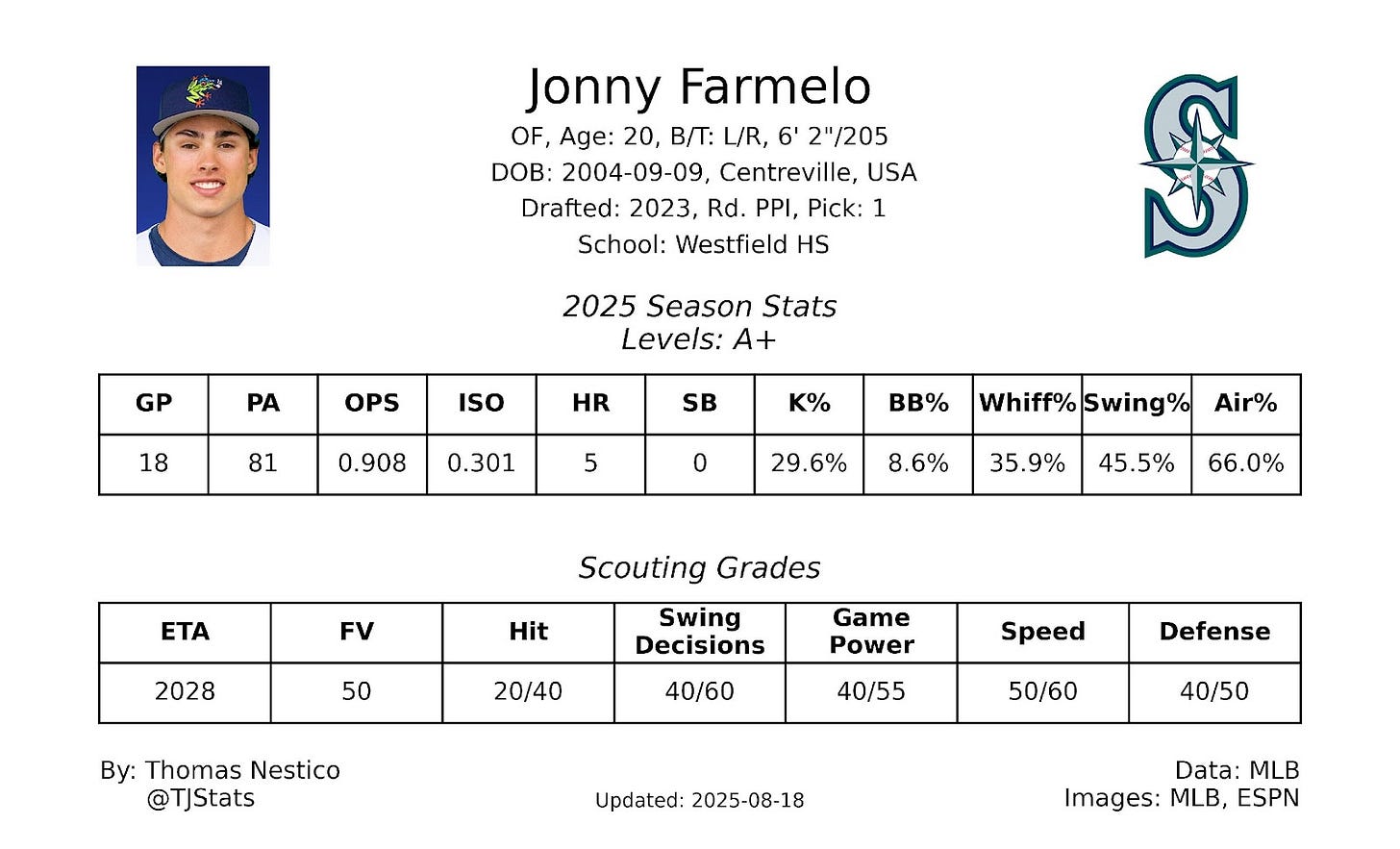






Quintero is in almost all the other top 100 I see (at least the one's I consider worth their salt). What keeps him out here? Lack of historical information?
I’m always fascinated by evaluators who view some prospects so differently compared to their industry counterparts. Ex: Walked Jenkins, by fantasy prospects, is a consensus top 10-15 guy. I’ve never seen him lower than 20. Seems like a guy like Emmanuel Rodríguez should be dinged for health more than Jenkins. Same with DeLauter or even Marcelo Mayer.